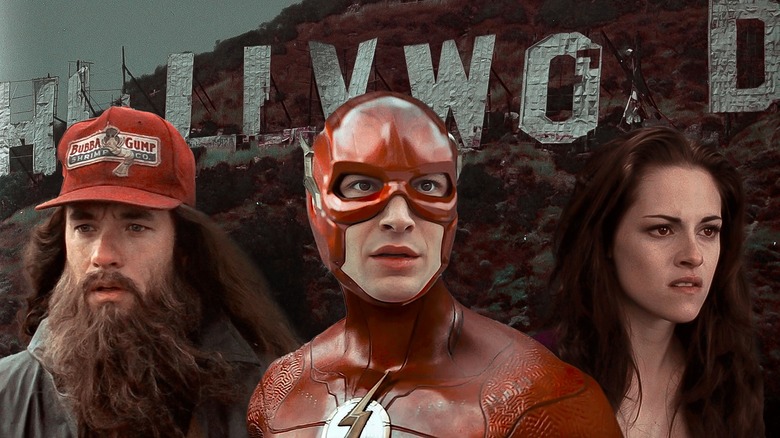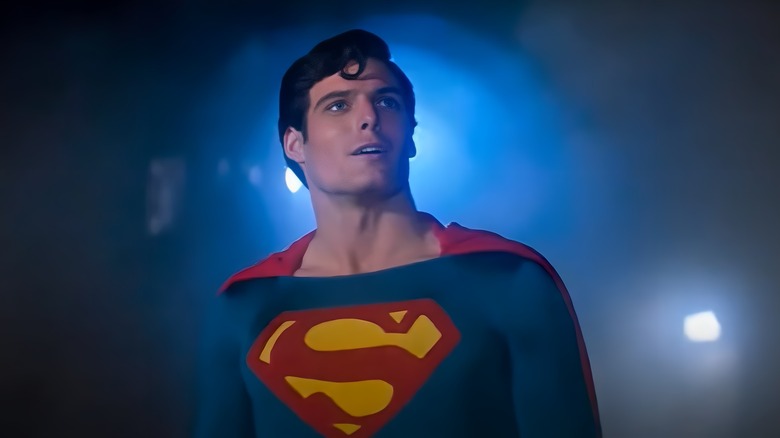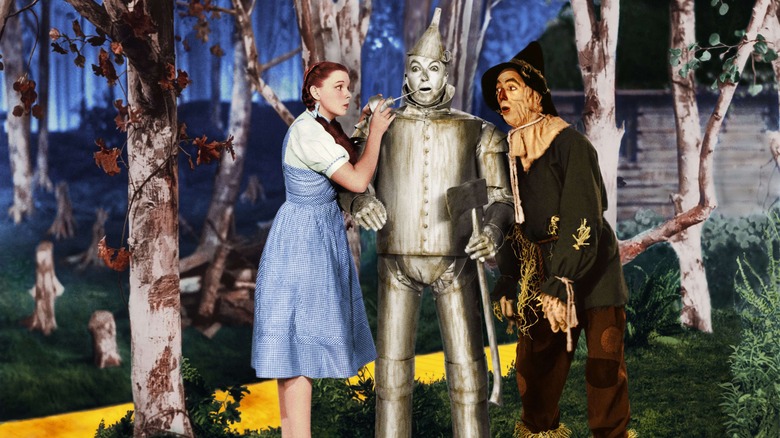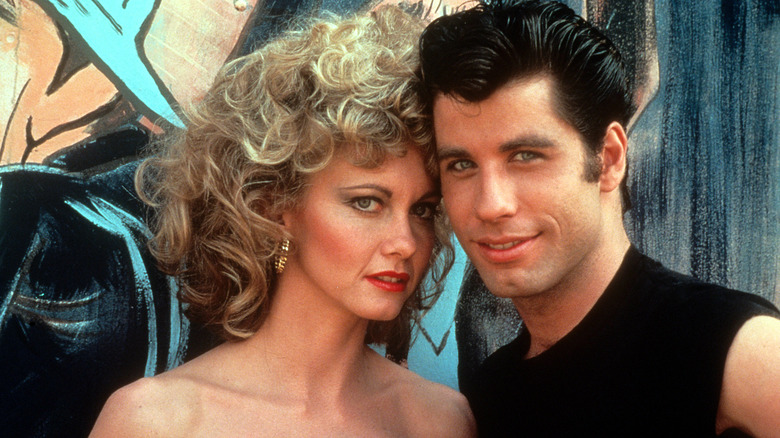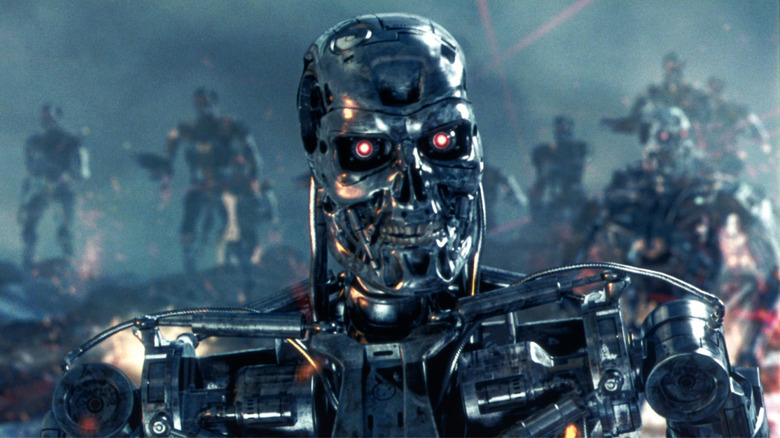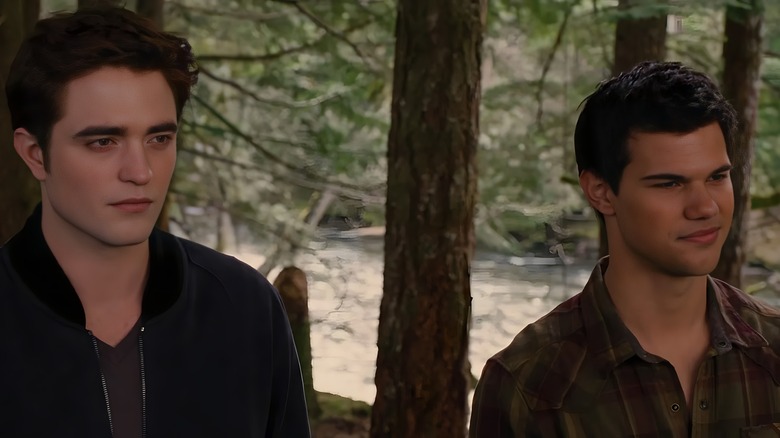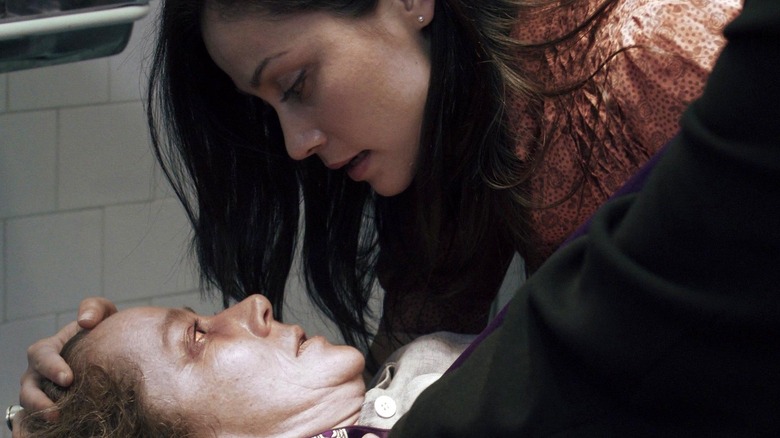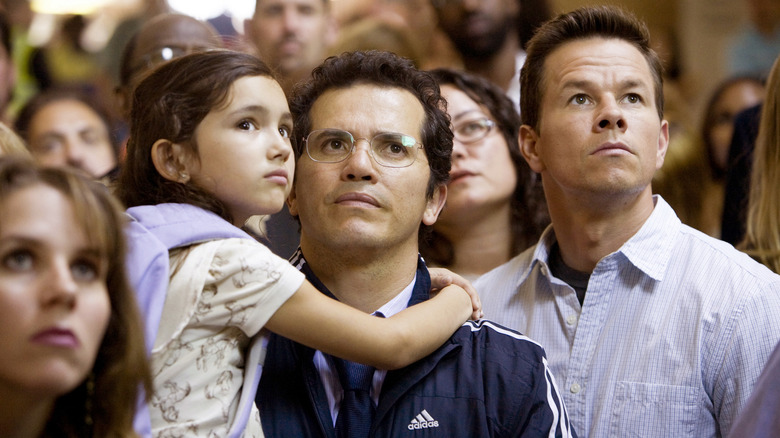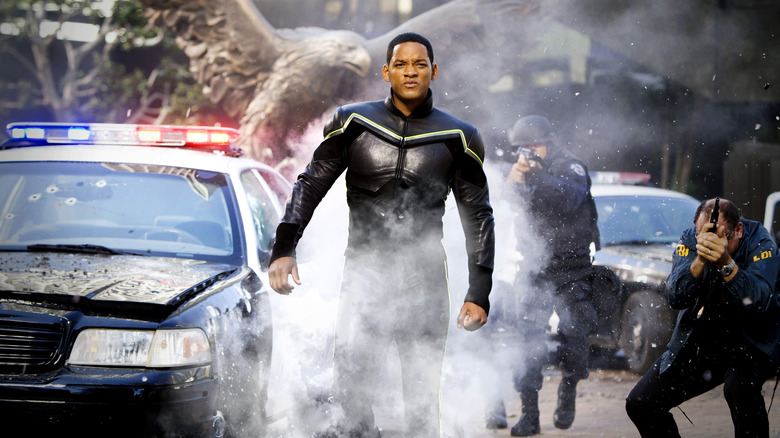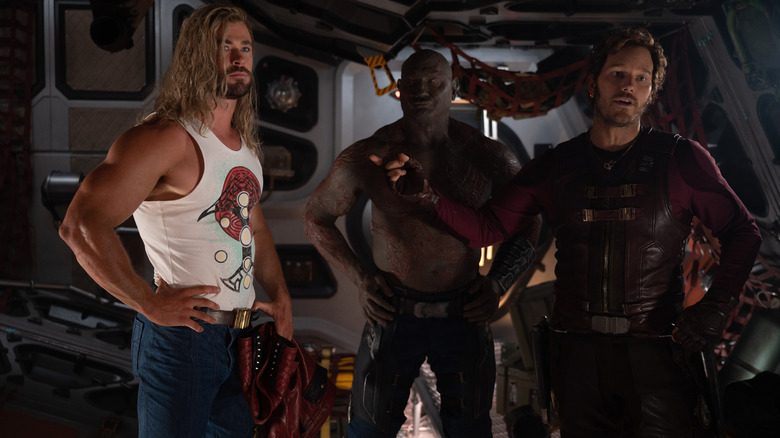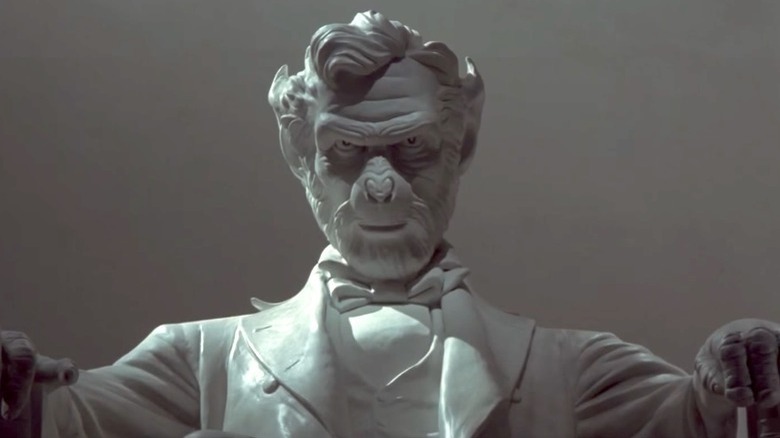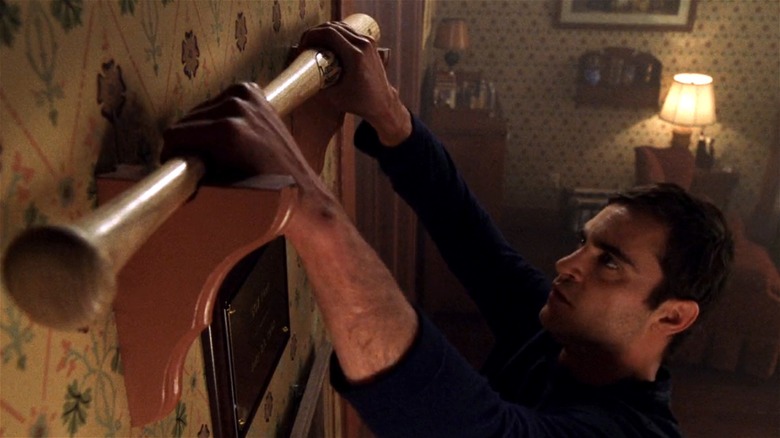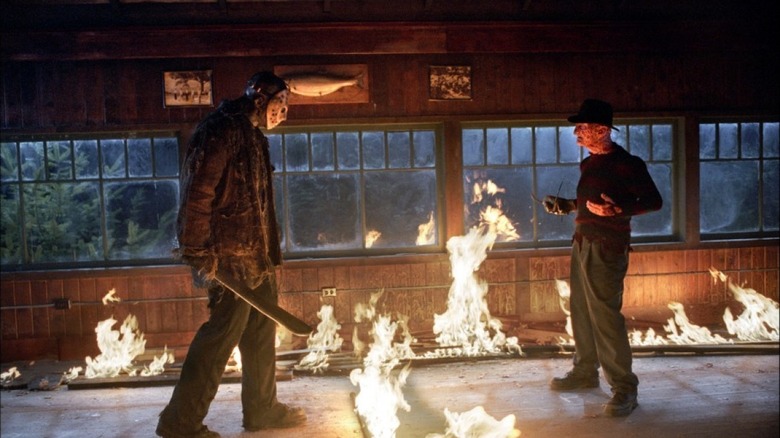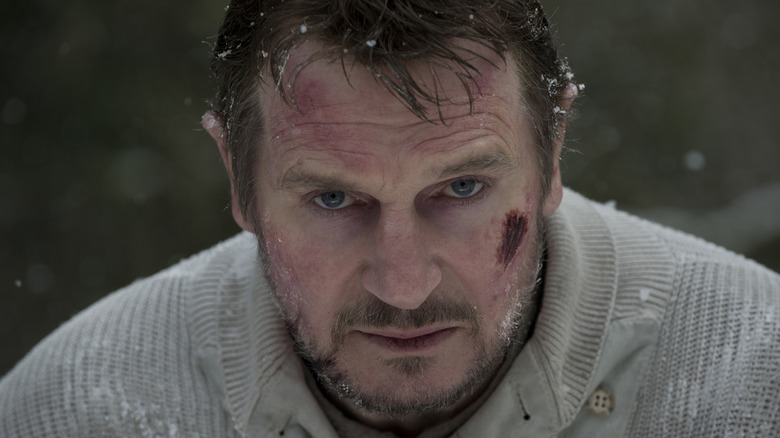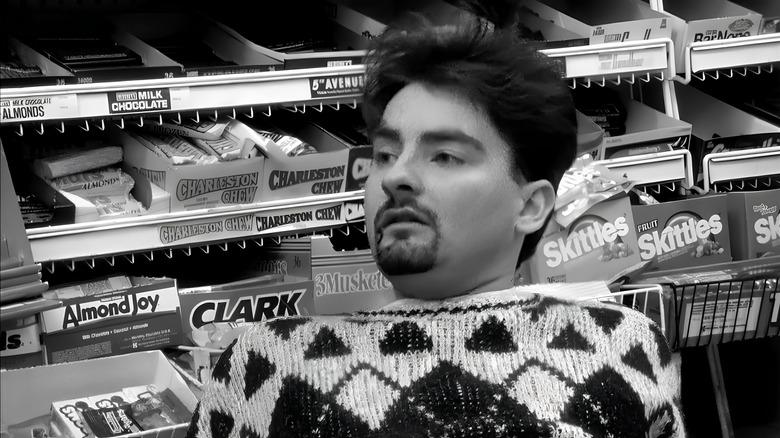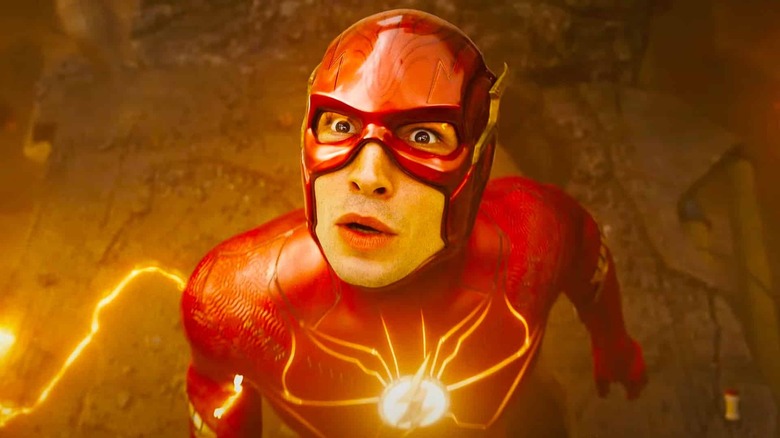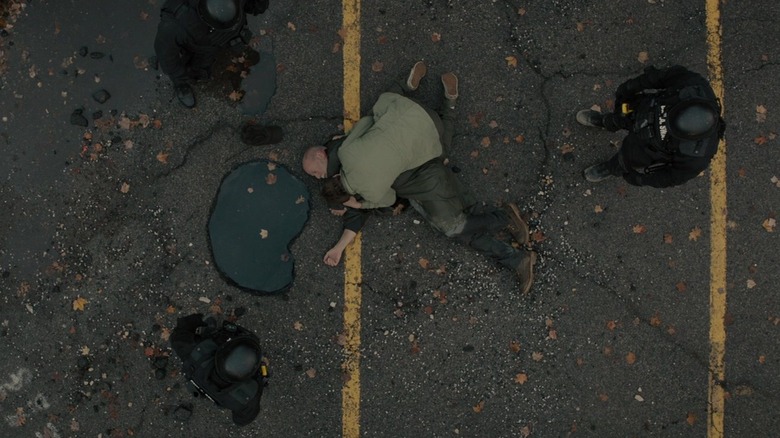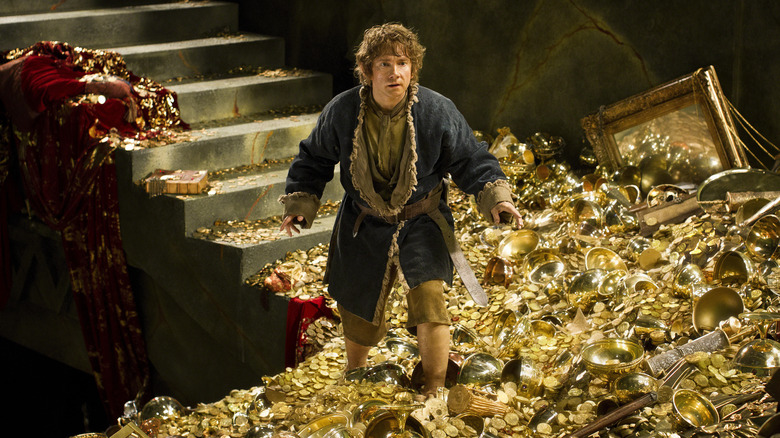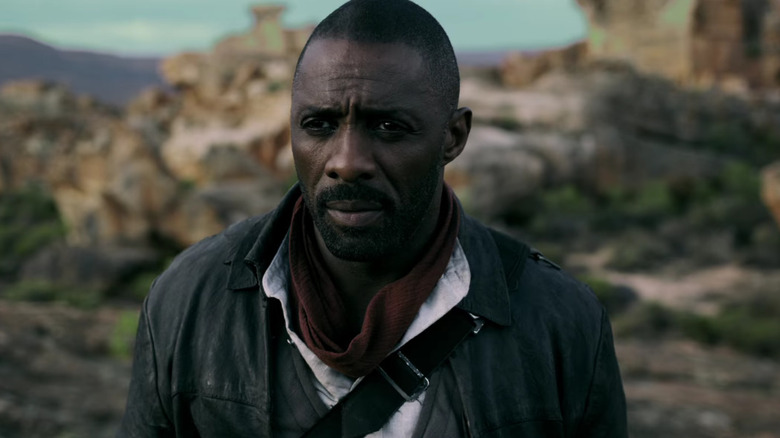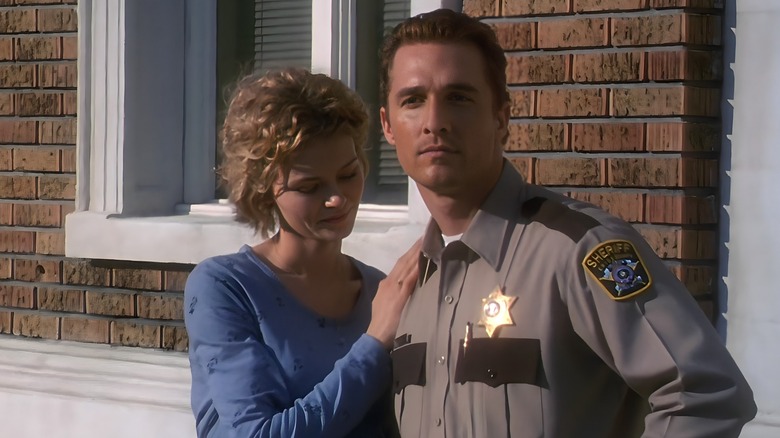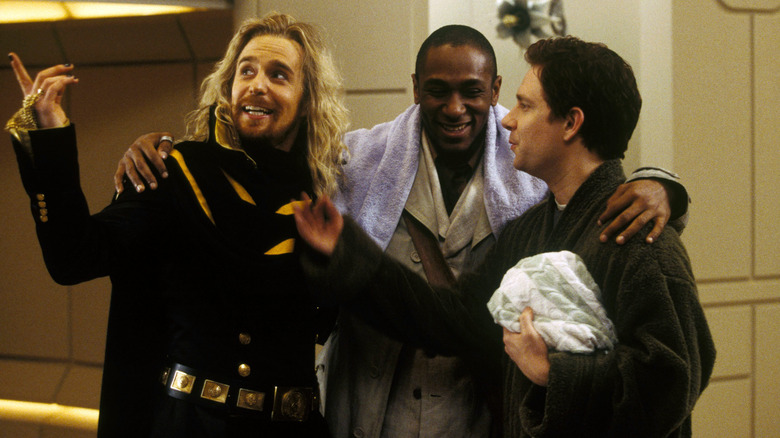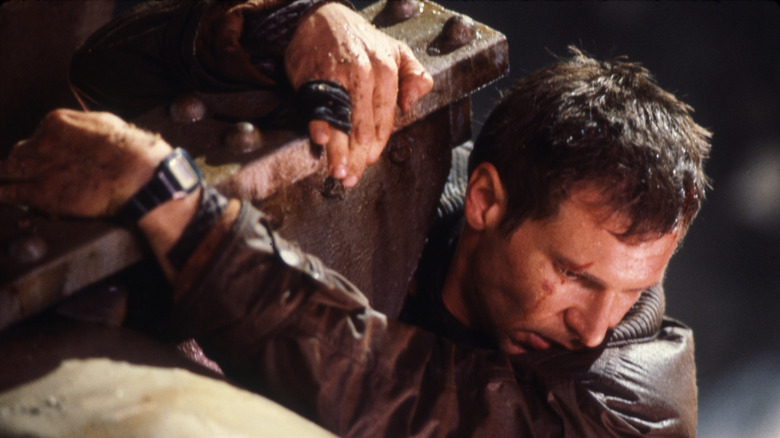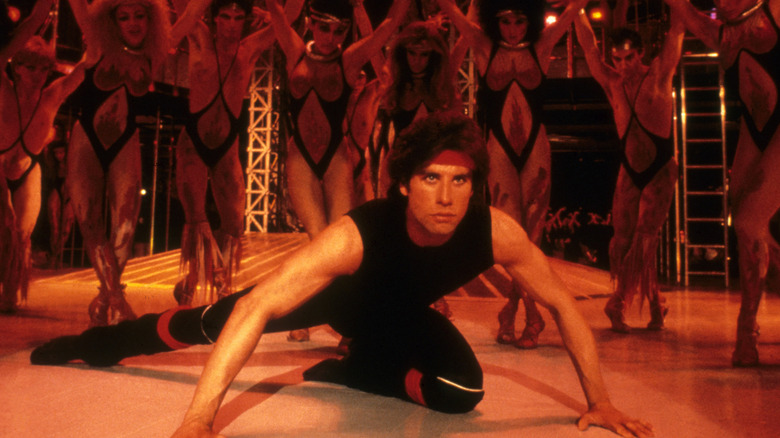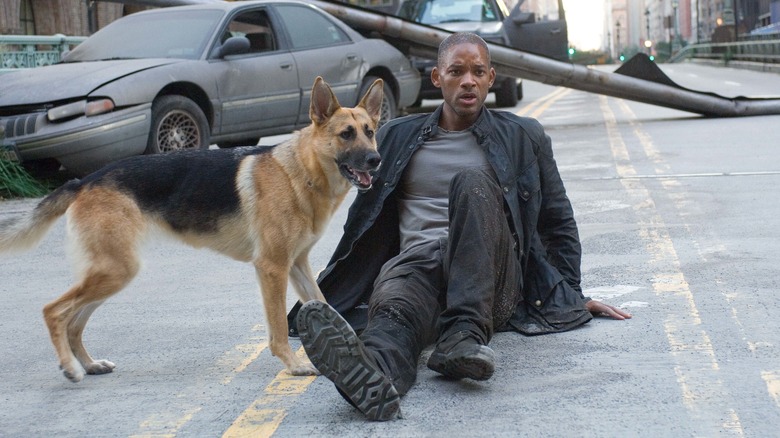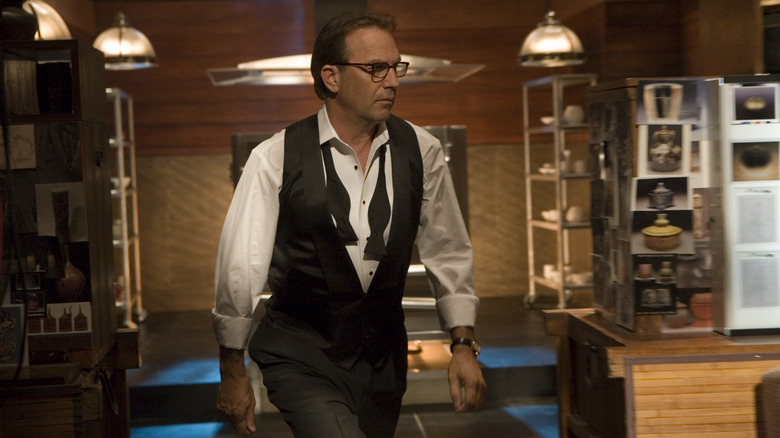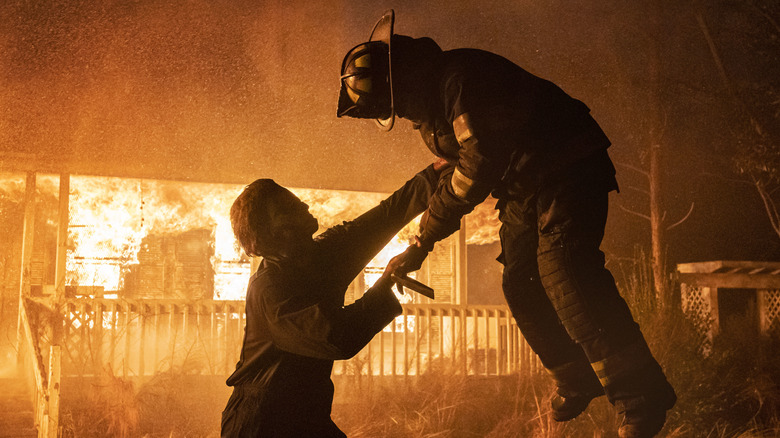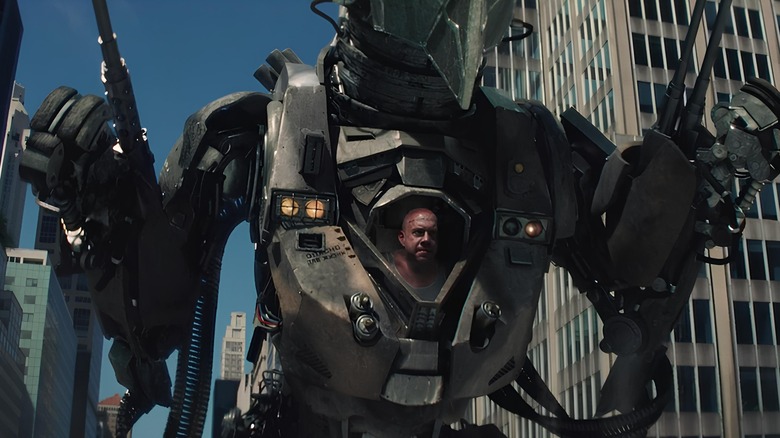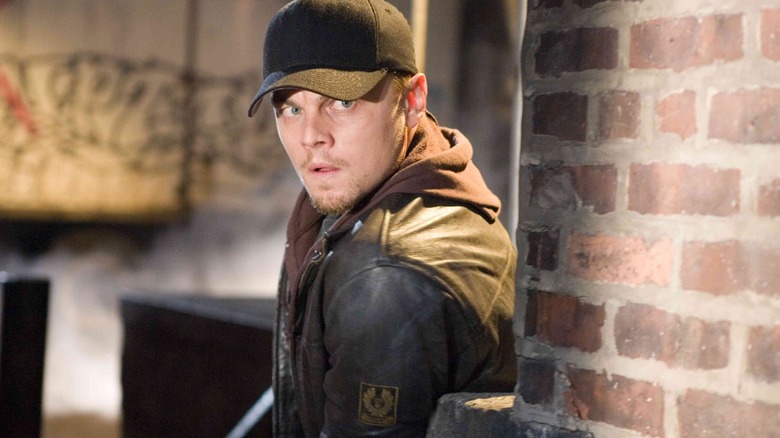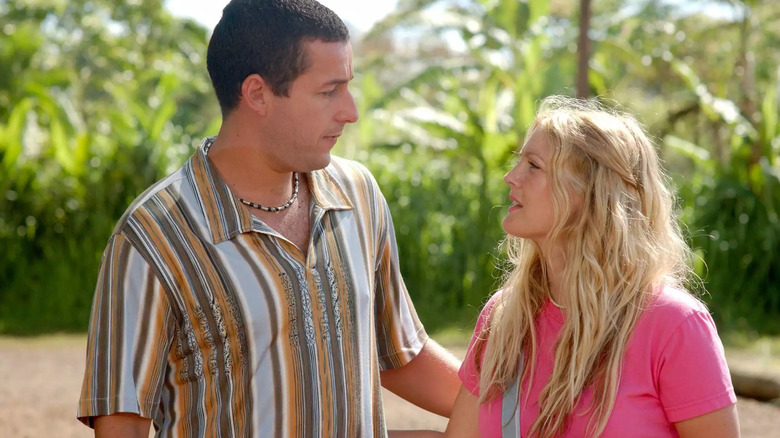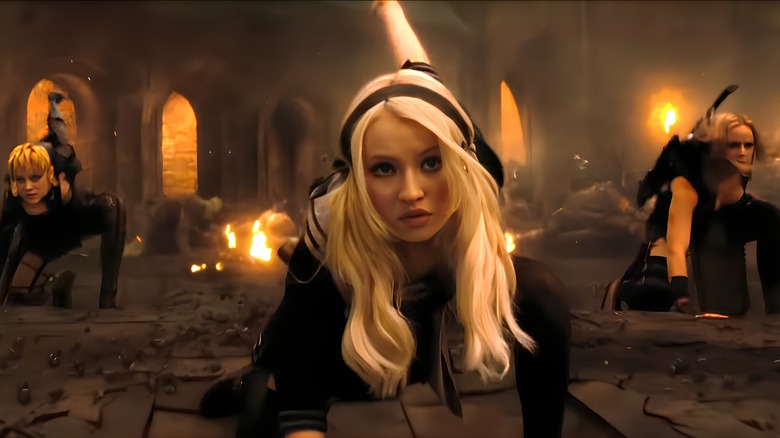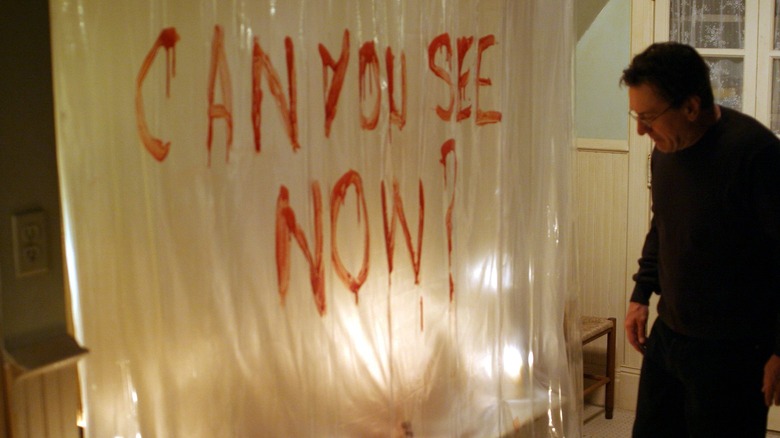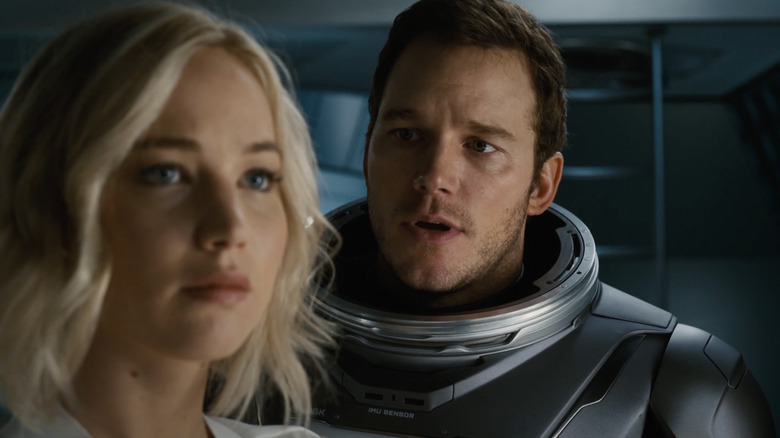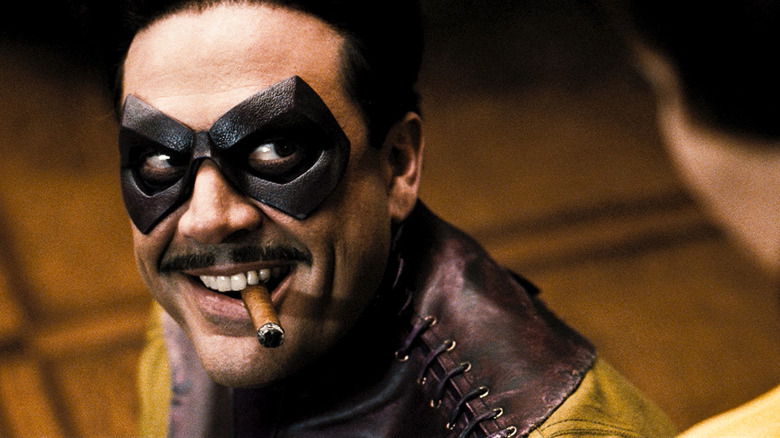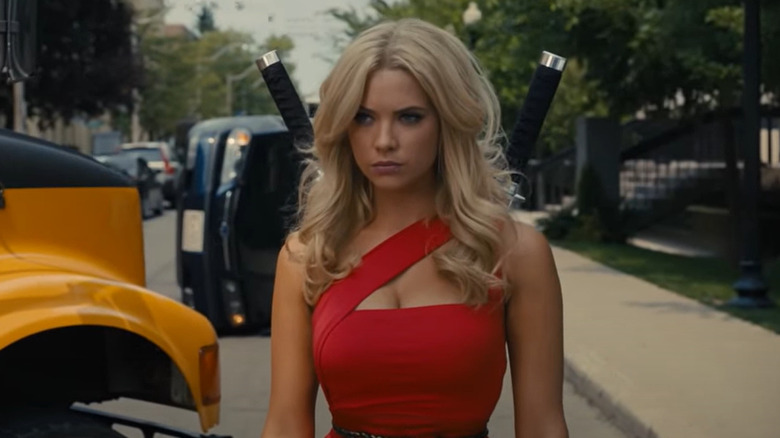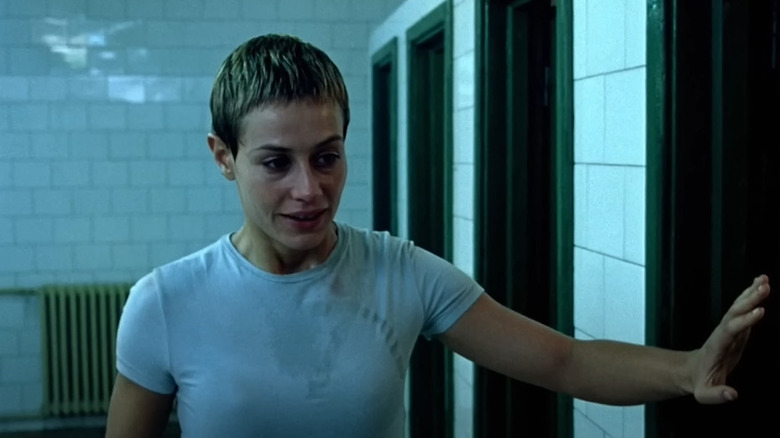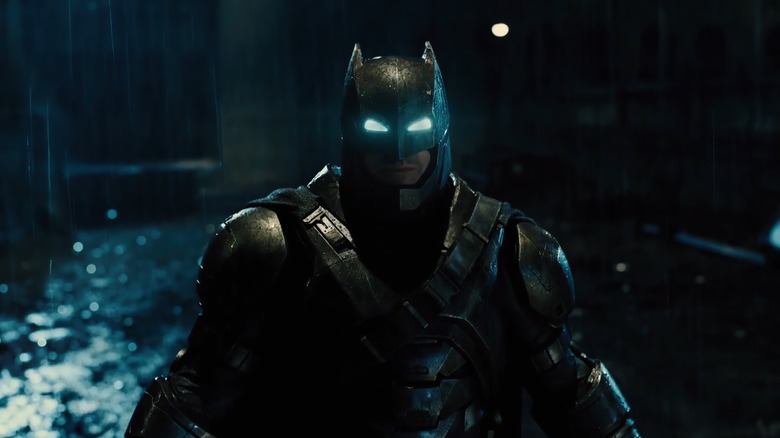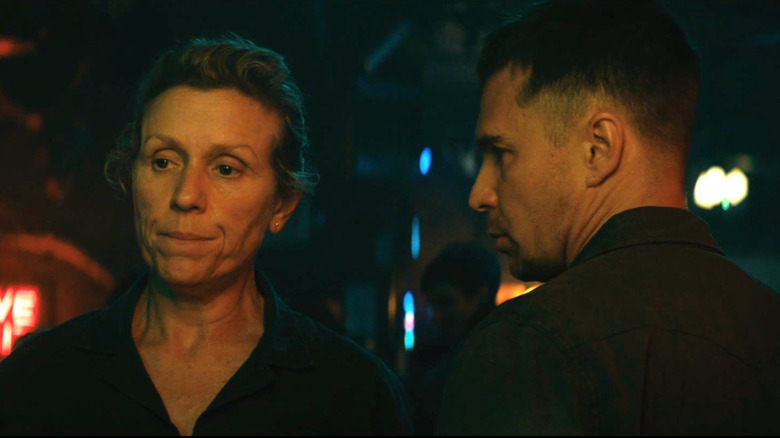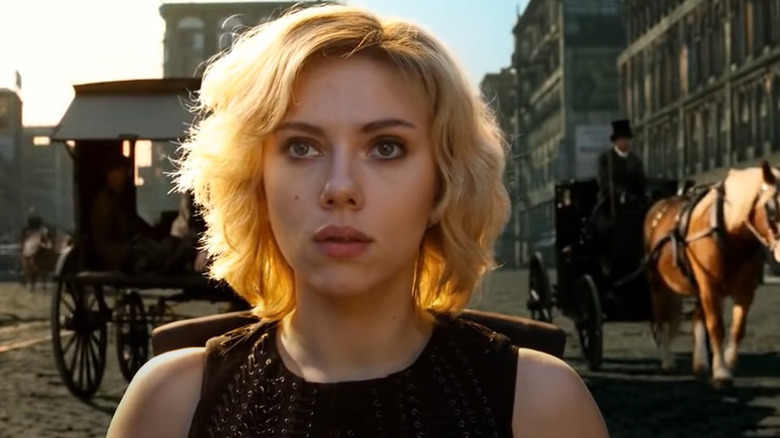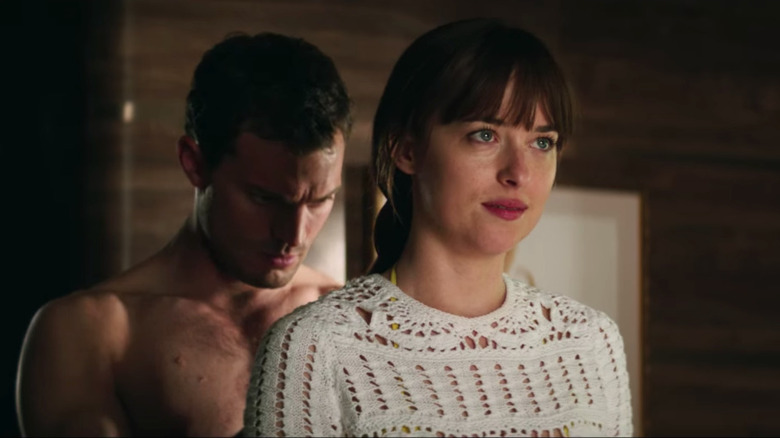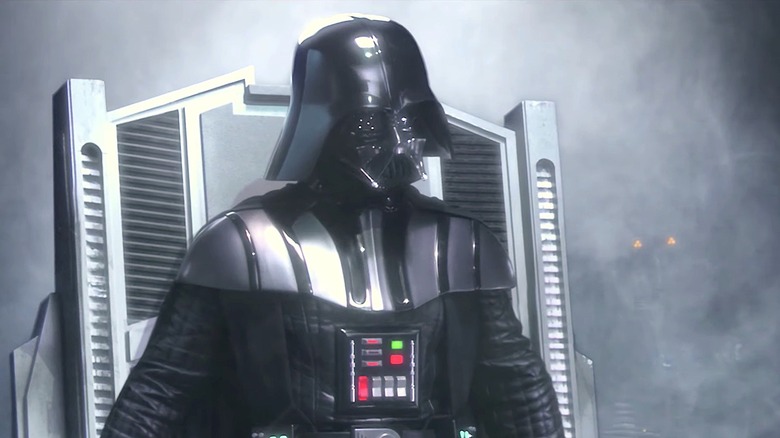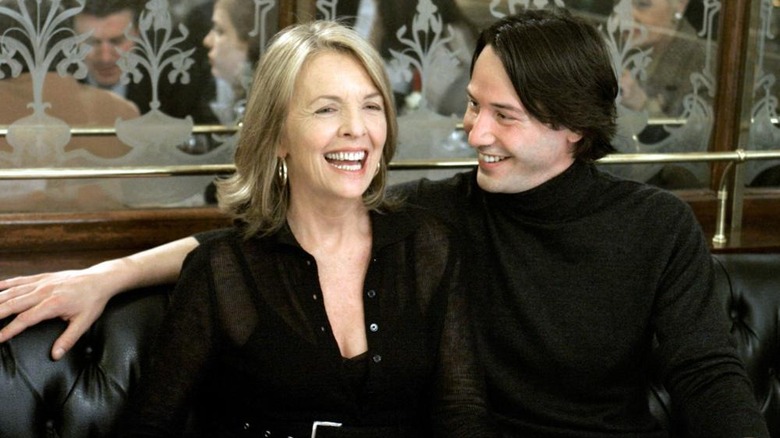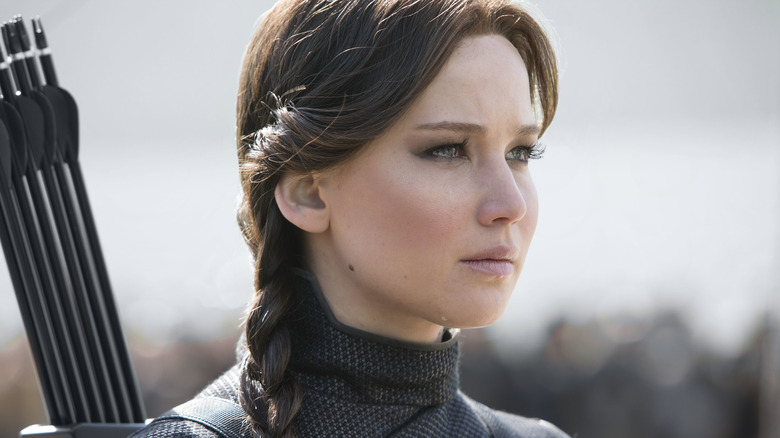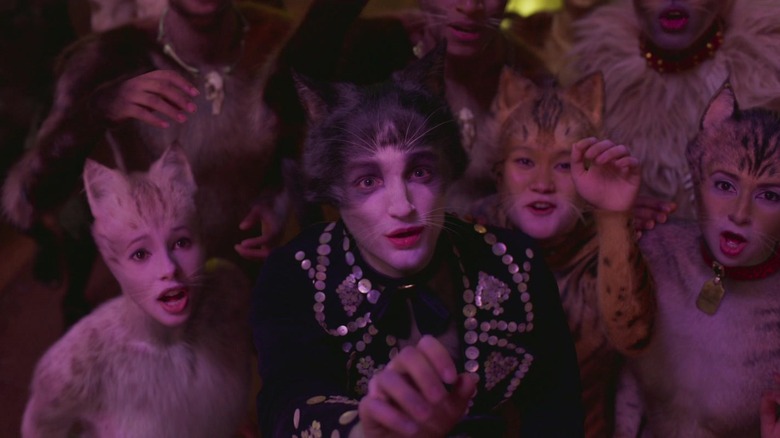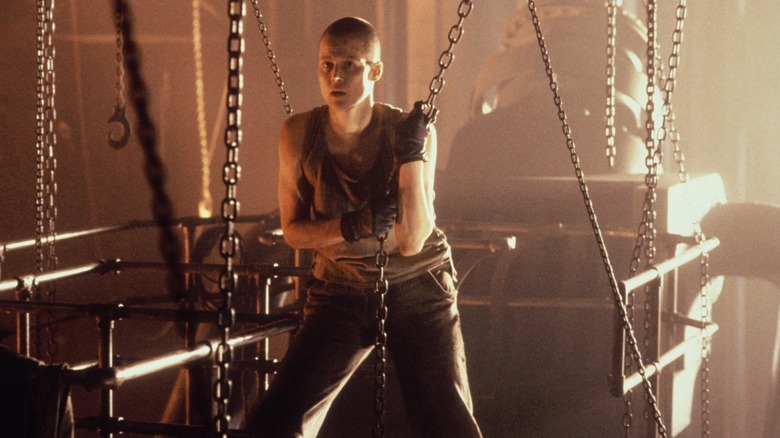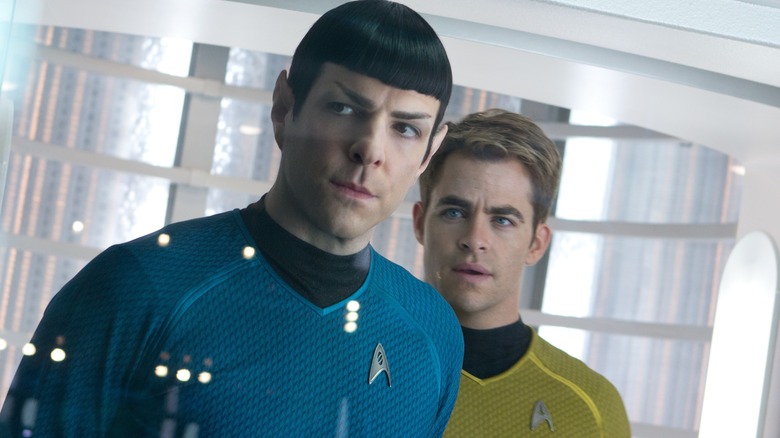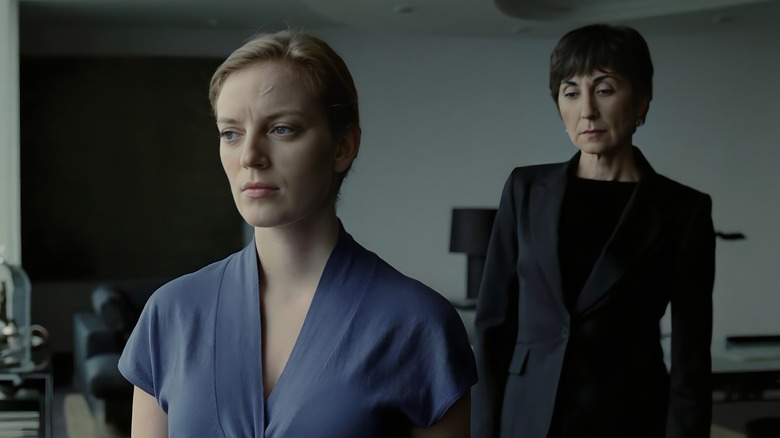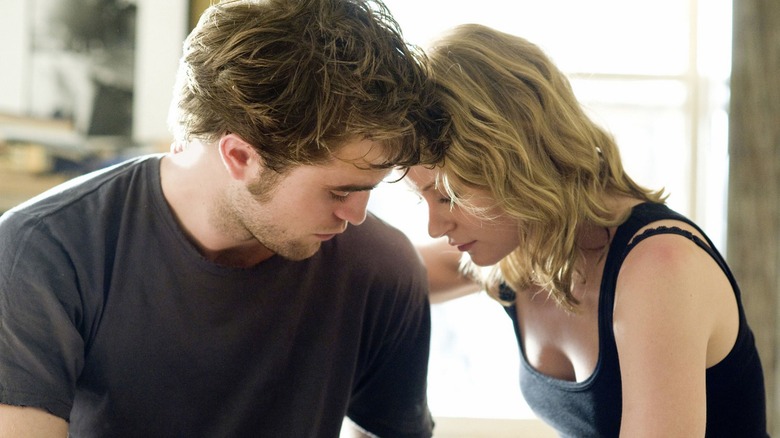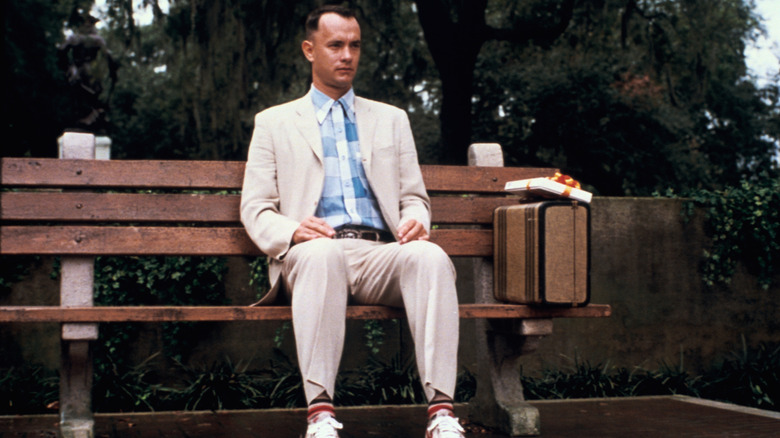50 Worst Movie Endings Of All-Time
It happens alarmingly often. You settle in to watch a movie — maybe it's new, or maybe it's a flick you missed back when it came out — and you're excited for it. Perhaps you paid an exorbitant amount of money to go see this movie in a theater with a box of Sour Patch Kids, or maybe you're on the couch with a big bowl of microwave popcorn in your lap. Whatever the case, you've signed up to devote the next 90 minutes (or three hours) of your life to being fully absorbed in the story that the film wants to tell. You're amped. You're ready.
And then sadly, in these cases, your optimism proves to be a mistake. An enormous misstep, a tragic miscalculation. Because sometimes, even the most awesome movie will betray you with an awful, utterly infuriating ending.
It happens only after you've allowed yourself to get sucked in. After you're invested to see it through. And then they end it ... like that? And as the credits roll down the screen in a perfect mirror to the tears of frustration rolling down your cheeks, there's only one conclusion you can draw: Wow, that ending stunk, and the movie is ruined. From that day forward, even hearing the title of the film will make you angry, because all you'll be able to think about is how badly it concluded.
When this happens, there's only one thing left to do: place this abysmal ending alongside the many, many other terrible endings from cinema's past. These are the 50 worst endings in movie history.
Superman's ending removes all of the stakes
1978's "Superman" is a landmark superhero film. While the Man of Steel existed in comic books, radio dramas, and TV shows before 1978, Richard Donner's blockbuster cemented him as the preeminent superhero for the global masses and provided a blueprint for a film that caped crusader flicks still build from this day. What's more, the flick boasts an all-star cast that includes Marlon Brando, Margot Kidder, Gene Hackman, Ned Beatty, and Jackie Cooper, to say nothing of Christopher Reeves' defining turn as the title character. What could go wrong?
Sadly, "Superman: The Movie" is let down by a terrible ending that makes all of the preceding drama feel pointless. After Lois Lane (Margot Kidder) gets killed in an earthquake, Supes turns back time by flying around the Earth at warped speed. This allows him to save Lois, stop the missile attack of Lex Luthor (Gene Hackman), and imprison the bad guys. Afterward, our hero takes to the skies knowing that the villains have been defeated and his crush is alive and well.
This is a cop-out conclusion. In addition to unveiling a ridiculous time travel concept, it removes all of the stakes from the story. If Superman can turn back time and rewrite history, then what's the point in giving him hurdles to overcome? How are we supposed to buy into the perilous situations he finds himself in when we know that he has this trick up his sleeve? What's the point in killing off major characters if the emotional impact is going to be cheapened with a cozy resurrection afterward? A shame, really, as "Superman: The Movie" is a good flick. In retrospect, though, the all-too-convenient ending stops it from becoming a great one.
The Wizard of Oz is why we keep having 'it was all just a dream' endings
It's been almost 100 years since "The Wizard of Oz" transformed Judy Garland into something more akin to a legend than a mortal. The musical holds a sacred place in many hearts, presumably even the Tin Man's (Jack Haley). Even so, enough time has passed that we can rag on it a little, right? As a treat? Without the pitchforks?
Listen, "The Wizard of Oz" beautifully blends the magical and the mundane, the technicolor and the monochrome, but it also features what might be the most famous instance of cinema's most loathsome narrative device — the "it was all just a dream" trope.
Obviously, Oz is not real in our world, but the fact that it's also not real in the fictional world of Victor Fleming's classic film kind of ruins the whole vibe, because the dream trope recontextualizes everything that came before as meaningless. Dreams don't matter. They just don't. Narratively, they wedge another degree of separation between the story and its audience, people who already suspended their disbelief to engage with a work of fiction, only to find out that it's even fictional within the fiction.
Guess what else the dream trope ruins? L. Frank Baum's original story. In Baum's novel, Oz isn't just a dream, it's a literal place that Dorothy goes. The lessons she learns there matter because they actually happen to her, and even lead to a whole fantasy universe of sequels that Hollwood still hasn't tapped into. But no, Fleming's adaptation delegitimizes Dorothy's growth by saying, "Just kidding! The truth was inside you all along, Dorothy. Also? You probably have a concussion."
Grease ruins all its storylines at the last second
1978's "Grease" is something you either love or hate. Whatever your feelings, though, the film's ending — which wraps up its plotlines in a confusing burst of magical realism, shrugged shoulders, and teenage hormones — actively ruins the imperfect but fun-filled ride that came before it.
Miles of ink have been spilled on the movie's unfortunate double-makeover ending, which sees Sandy (Olivia Newton-John) squirm into leather pants and puff a cigarette, embracing her destiny to become a Pink Lady — on the last day of senior year, making her decision a thoroughly moot point — while, Danny (John Travolta) plans on going full prep for her. The problematic nature of this speaks for itself, as neither should be required to change a thing about themselves to find real (teenage) love. But "Grease" carves its own pathway out, ethics be damned.
Meanwhile, the movie's climax randomly abandons its single mother plotline. After devoting a chunk of its last third to building a careful arc for Betty Rizzo's (Stockard Channing) pregnancy, it's discovered she suffered a false alarm, and it's settled with the aforementioned shrug of the shoulders. She gets back together with the thoroughly unsympathetic Kenickie (Jeff Conaway), whom she'd previously lied to about the possible pregnancy.
Finally, after the T-Birds and Pink Ladies have vowed to always be together, Danny and Sandy climb into Greased Lighting ... and the car inexplicably takes off into the afternoon sky.
Yes, "Grease" has other flights of fancy during its runtime, but a musical number like "Beauty School Dropout" is clearly meant to be a fantasy sequence. The flying car? If the meaning was clear, then Travolta and Newton-John wouldn't have had to spend decades arguing with fan theories about how Sandy is dead the entire movie.
Terminator 3: Rise of the Machines made the first two movies pointless
"The Terminator" and "Terminator 2: Judgment Day" cover a specific and captivating beat, twice over: An evil AI superintelligence will soon declare war on humans, the fate of mankind depends on one person, and both humans and machines send their own champions in the past to protect or kill said person. Brutal action ensues, and Arnold Schwarzenegger declares his intention to be back. In the end, the survivors face a future that is at least slightly more hopeful, thanks to their actions.
This hope that the dark future may somehow be avoided is the franchise's entire beating heart, especially in "Terminator 2," in which the characters risk everything to avert the apocalypse.
And then "Terminator 3: Rise of the Machines" pulls the rug from under the first two movies and confirms that humanity is absolutely destined to get wrecked, thank you very much. To make it more painful, "Terminator 3" is careful to cover familiar terrain right up until the end: the final showdown between T-850 (Arnold Schwarzenegger) and T-X (Kristanna Loken) leaves John Connor (Nick Stahl) and Kate Brewster (Claire Danes) stuck inside a nuclear shelter as Skynet eradicates mankind. This locks John into the "humanity's last champion" role, as he starts answering the panicked contact attempts that flood in.
By confirming that the apocalypse and John's role in it were predestined, "Terminator 3" renders the first two movies pointless and destroys the spark of hope they hinged on. Evidently, the protagonists of "The Terminator" and "Terminator 2" could just have sipped lemonade on a porch and watched as the machines sent to kill them kept malfunctioning.
What happened to "Terminator" movies after that? One underwhelming entry after another, from "Terminator Salvation" to "Terminator: Dark Fate."
The Twilight Saga: Breaking Dawn - Part 2 straight-up lies to its audience
There are so, so many stupid things within the "Twilight" franchise, but it is a truth universally acknowledged that the ending of its final movie, "Breaking Dawn — Part 2," is maybe the dumbest thing contained within the series.
In short, after Bella Swan (Kristen Stewart) and Edward Cullen (Robert Pattinson) unwittingly produce a half-vampire, half-human baby, the entire Cullen family realizes that they'll be targeted by the ultra-powerful Volturi vampire council. They assemble an army of allies and start training, and when the Volturi arrive in the Pacific Northwest to genocide the Cullens and their cohorts, an enormous battle kicks off. Frankly, it's incredible. The patriarch of the Cullen family, Carlisle (Peter Facinelli), is swiftly and brutally murdered, as is his surrogate son Jasper Hale (Jackson Rathbone). Several werewolves — who, it should be said, range from teenagers to young adults — are killed in action, and even a few of the Volturi fall, including their leader Aro (Michael Sheen). It is, without any shadow of a doubt, the most metal moment in the history of "Twilight."
Except it's not. It's a lie. The whole thing is a vision of what could happen courtesy of magical vampire Alice Cullen (Ashley Greene), who can see potential outcomes of decisions or something equally silly and nebulous. None of that happens, and everybody is fine. Basically, what really happens is that the good vampires and bad vampires talk about their feelings and how the baby isn't a threat, and then everybody goes home. Everybody then lives happily ever after. It's infuriating, and it sucks (pun intended).
The Devil Inside ends with a dead URL
Hollywood always jumps on new technologies. Whether it's celebrating the advent of technicolor, bringing in music and dialogue via the talkies, or turning from film projection to digital, movies love to promote new trends. In the case of "The Devil Inside," though, the 2012 horror film made a bad, bad choice to embrace technology in the most distracting way — a choice that only gets worse with age.
"The Devil Inside" concerns itself with Isabella Rossi (Fernanda Andrade), daughter of a woman accused of murdering three people during an exorcism. Years later, Isabella seeks out her mother in the asylum where she has been incarcerated for decades, presumably processed by multiple demons, to film a documentary. The film ends with Isabella's own possible posession, the likely death of her filmmaking compatriots ... and a title card telling audiences to go to www.TheRossiFiles.com.
This was dumb enough when the movie came out. Keep this in mind: Smartphones were in their infancy, and browsing the web from your phone was a nascent technology back in 2012. That meant audiences would have to go all the way home to look up the film's website, which offered no additional information about Isabella's fate at all — just clips from the movie which no longer work after the sunsetting of Adobe Flash, general information about exorcisms, and a chat forum that allowed audience members to troll each other about their belief in exorcisms. Critics unsurprisingly torched "The Devil Inside," which went on to have the third best January opening at the time – and the biggest second-week slide.
In the 2020s, this ending is even worse, because that website stopped functioning in 2013. Today, you can only view it (if you want to) via the Wayback Machine.
The Happening's climax is Shyamalan at his laziest
When it comes to ending a movie with a bang, M. Night Shyamalan is cinema's Little Girl with the Curl. When he's good — as in the endings for "The Sixth Sense" and "The Visit" — he's very, very good. But when he's bad (see: "Old") he's horrid. And bad Shyamalan endings don't get much worse than "The Happening."
"The Happening" isn't great to begin with, to be clear. The overall film provides viewers with a bizarre mixture of awkward action movie antics and dire thoughts about climate change, the latter of which might be more impactful if the audience weren't subjected to hours of people running away in terror from the breeze as it tries to kill them via zombielike possession and suicidal ideation. Then, the film's ending is Shyamalan's least creative ever: just when you think Eliot Moore (Mark Wahlberg) and his wife, Alma (Zooey Deschanel) are finally safe and sound, a whole new wave of pollen-driven deaths begin in Paris. It's the same "oh-no-it's-not-over-yet!" moment that thousands of horror directors have done over the years in more B-movies than you could ever name. Coming from Shyamalan, it's well, well beneath him, and perhaps the most disappointing moment from his career.
If you or someone you know is having suicidal thoughts, please call1-800-273-TALK (8255) or text HOME to the Crisis Text Line at 741741.
Hancock ruins itself with one bad twist
"Hancock" is a lesson in how an almost-great movie can spiral out of control with a bad plot twist.
For the first two-thirds of the film, audiences can't help but be engaged by the titular superhero's (Will Smith) detached, self-destructive lifestyle, and his attempts to improve his public image with the help of PR expert Ray Embrey (Jason Bateman) could've easily carried the movie to the finish line — or even set up a fun film series, frankly. The film's darker original screenplay, titled "Tonight, He Comes," earned accolades — and a spot on the 2005 Black List — for a reason, and even if it changed quite a bit in its journey from disturbing psychodrama to PG-13 summer tentpole, the first section of the finished film was smart, fun, and engaging. However, the script's original ending, which involved Hancock brutally murdering an entire police department, was never going to fly in theaters — and evidently, the filmmakers didn't know what to replace it with, resulting in a plot twist nobody liked.
Specifically, "Hancock" goes from great to mediocre with the revelation that the amnesic Hancock and, conveniently enough, Ray's wife Mary (Charlize Theron) are ancient soulmates and last representatives of a borderline divine species. Yes, there's a cool fight. But come on, the movie didn't need any of that overcomplicated mythology stuff, and the sudden tone shift is so jarring the movie never recovers.
Then, the cherry on top is the movie's final scene, where Hancock inadvertently destroys Ray's life: as a perceived favor to his friend, the superhero paints Ray's heart-themed business logo on the surface of the Moon. The countless-gallons-of-paint gesture is clearly intended to be heartwarming, but imagine something like that happening in reality. The Outer Space Treaty specifically forbids damaging space objects, and since the damage in question is Ray's logo, the government (along with everyone else who now has to look at that damn heart every night) will want a word with the guy. Thanks for the legal nightmare, Hancock.
Thor: Love & Thunder apparently existed just to end on a bad joke
Taika Waititi's excellent "Thor: Ragnarok" was always going to be a tough act to follow, but "Thor: Love and Thunder" tackles the task with its shoelaces tied together. The movie insists on making nearly every single one of its scenes "fun," at the expense of both narrative cohesion and the utterly chilling villain the film has at its disposal. From Russell Crowe prancing around as Zeus to the film's pathological need to insert a comedic beat in even the most dramatic scenes, a lot of the movie feels like it's a huge, long-winded joke ... which, actually, it is, as the ending disastrously spells out.
To be clear, we're not talking about the emotional climax of the movie, which is surprisingly solid. When Thor (Chris Hemsworth) manages to convince Gorr (Christian Bale) that the death of all gods is not the answer, and promises to look after Gorr's child if the villain instead just chooses to bring her back to life, it's actually pretty sweet. Very few conflicts in the MCU tend to get resolved by talking and adoption.
Unfortunately, this is still "Love and Thunder," and the actual ending of the movie reveals that Thor and Gorr's daughter Love (India Hemsworth) are now a galactic crime-fighter team known as ... yes, "Love and Thunder." And suddenly, it becomes clear that the entire movie was designed for this final revelation. While there's definitely audacity to be admired here, it also means that Waititi's sophomore MCU effort comes across as a big-budget joke setup to a punchline that just ... isn't good.
The Snowman ends on thin ice
Unless you want to avoid offending the citrus fruit family, it's safe to call "The Snowman" a lemon. On paper, the movie had every chance to succeed. It had a creepy serial killer with a visually captivating modus operandi and a weird fascination with the protagonist. A colorful cast of characters were played by some of the finest actors in the business. Director Tomas Alfredson was a proven master of both thrill ("Tinker Tailor Soldier Spy") and chill ("Let the Right One In"). What could go wrong?
Everything. "The Snowman" faced a rushed production and money troubles that crippled the film, turning what could have been a "Se7en"-level crime thriller into a faceplant. Nothing fails harder than the ending, though. In Jo Nesbø's novel, the Norwegian detective confronts the killer in Oslo's iconic Holmenkollen ski-jumping tower and survives the ordeal with a highly specific speed handcuffing trick he recently learned and has been practicing as stress relief. The location and the trick are both inserted in the story early on, so their presence in the grand finale feels as natural as it is exciting.
In the movie, the killer (Jonas Karlsson) shoots Harry Hole (Michael Fassbender), leaving the hero lying wounded on a frozen lake. Then, the killer walks towards the hero, at which point Hole quickly notes that the murderer's mommy issues were actually daddy issues all along. With some extremely half-hearted telegraphing, the ice breaks under the Snowman and he just ... drowns, like he was actively trying to get underwater as quickly as possible. That's it. Game over.
This was probably riddled with symbolism at some point in the production. In the finished movie, however, the scene is mostly impressive because even after all the disappointments throughout its duration, "The Snowman" still finds a way to give the viewer one last anticlimax.
Tim Burton's Planet of the Apes climax is confusing on a cosmic level
"Never mess with the classics" is a piece of advice that Hollywood has historically ignored. Even then, Tim Burton's "Planet of the Apes" remake took things in a particularly bold direction by taking one of the greatest endings in the history of science fiction and replacing it with an infamous plot twist that ruined the movie.
The 1968 movie famously ends when George Taylor (Charlton Heston) finds the half-buried remains of the Statue of Liberty, realizing that the titular planet he's stranded on is actually far-future Earth. The 2001 Burton version wants none of that. Instead, the Planet of the Apes was never Earth, and the timey-wimey shenanigans of the electromagnetic storm that kicks off the plot send Leo Davidson (Mark Wahlberg) there thousands of years after the animals aboard space station Oberon crash-landed on the planet, allowing their descendants time to evolve and become sentient. The end of the movie once again sends Davidson through that same space storm — only to discover that the exact same evolved apes now rule Earth, with the Lincoln Memorial bearing the image of the movie's antagonist, General Thade (Tim Roth).
What happened? Did Davidson end up in some strange parallel dimension that just happens to be ruled by a Thade lookalike? Did our Thade timestorm his way to Earth and take over? Where did the other apes come from? Did he somehow create an entire evolved-ape society and eradicate humanity? No one knows, least of all the viewer.
The ending might be a homage to the original novel by Pierre Boulle, but it's just confusing, and while a sequel might've clarified things, it was wise to walk away and resurrect the franchise with "Rise of the Planet of the Apes" instead.
Signs ends with a swing and a miss
M. Night Shyamalan's "Signs" ambitiously attempts to convince us that life's arbitrary, often tragic occurrences all happen for a reason. But they don't, and it doesn't.
It's not just that intelligent aliens who are mortally averse to water (or demons who are averse to holy water, as one interpretation suggests) decide to raid a planet whose atmosphere is lousy with the stuff. There's plenty in the film that could (albeit loosely) justify all this with the old stand-by of, "well it's not literal, so, it's fine." At least, it would be, if the ending upheld such a metaphor.
But again: it doesn't. We're asked to believe that a former baseball player would not instinctively grab the baseball bat he's standing next to when a giant alien is standing across from him, holding his beloved nephew in its arms. We're further asked to believe that had his sister-in-law not died in a gruesome, highly-specific way, said baseball player's brother (Mel Gibson's disillusioned former priest, Graham) wouldn't have "seen" the bat on the wall, and known to tell him to "swing away" at the alien. Oh, and we're asked to believe that said nephew has asthma, and Graham's daughter has a water hang-up, so they can fend-off the alien-demon monsters.
If you walk this metaphor back, you have to accept that the real premise of the film is: people lost their faith, so (non-literal) inner demons (literally) attack earth and can only be defeated by people regaining faith. But for Graham to so, so easily come to the conclusion the there is a divine plan, he'd have to have been secretly holding onto his faith all along. In which case, there would be no invasion, and the ending still doesn't work.
Freddy Vs. Jason undercut Jason's big win
"Freddy vs. Jason" is, frankly, an excellent movie. It pits the iconic villains from the "A Nightmare On Elm Street" and "Friday the 13th" franchises against each other in a way that honors the spirit of both sagas. Freddy Krueger haunts people's dreams, Jason Voorhees slashes his way through annoying teenagers, and in the end, they butt heads. The movie isn't complex or deep, but it knows its audience, and has a lot of fun.
Jason ultimately wins the battle between the horror icons, but his victory feels undercooked as a result of the film's closing scene, which sees Freddy's decapitated head wink at the audience while sporting a cheeky grin across his handsome face. This betrays the feeling that Jason took his opponent to school — which he absolutely did do, during their final showdown — and robs viewers of a satisfying conclusion.
Look, we all know that Freddy will always return from the dead, but the ending of "Freddy vs. Jason" didn't have to make it so obvious. The wink is a cheap attempt to have it both ways, even though the movie itself, up to that point, made it clear that Jason had won a hard-fought battle, fair and square. The wink is, in the end, pretty much the only thing the movie gets wrong. What's more, the fact that "Freddy vs. Jason" never received a sequel makes the ending even worse, as it was clearly added to tease more installments. At one point, there were plans in place to introduce Ash from the "Evil Dead" franchise into the mix, but the project never came to fruition on the screen (although the concept did inspire an excellent six-part comic book series).
Looking back, this last-minute ambiguousness wasn't the cliffhanger it was meant to be, but rather, a sad reminder of what could've been if a sequel had happened. "Freddy Vs. Jason" should've let Jason's victory be definitive until they knew another one was guaranteed.
The Grey ended right before the moment we bought tickets for
Remember back when the world waited with breathless anticipation to see Liam Neeson punch wolves in the snow with those brutal glass knuckles?
"The Grey" had a phenomenal trailer. Following the success of "Taken," if a funny look was thrown his way, you could be sure that Neeson was going to rearrange whatever face it came from, and audiences were there for it. In the preview for Joe Carnahan's bleak-looking survival movie — that had Neeson and a bunch of worn-down roughnecks facing the harsh elements of the Alaskan terrain — the final tease showed him looking right down at the camera while wrapping broken bottles around his fists. It was the perfect hook to get people in theaters.
What we didn't know, sadly, was that this wasn't just the last shot of the trailer. It was the last shot of "The Grey." And then it cut to black.
The marketing team of "The Grey" had the nerve to hype up a moment that we were never going to get. Audiences had paid good money to see Neeson give nature a whooping, and instead, we got him lunging at the screen like the last cheap scare of a horror movie. Now, marketing aside, "The Grey" is an entertaining watch. It didn't need to be sold on something we were never going to get. Instead, a decent Neeson movie became a disappointing one, made worse when it dared to give us a post-credit scene, tepidly showing the aftermath of the battle we'd been robbed of. People went to watch Neeson become the leader of the pack, but in the end, for "The Grey," all we saw was red.
Clerks' original ending was a major downer that didn't belong in the film
Kevin Smith's unique brand of gross-out humor and never-ending pop-cultural references may not be for everyone, it's hard to dispute that he was a defining voice of the 1990s. Of course, the reign of Smith began with his legendary independent film, "Clerks." The simple premise of two dudes working in a store — or more often, screwing around instead of working — may not be much to go off of, but "Clerks" soars all the same, and is one of Smith's most fondly remembered movies.
However, its legacy might not be so warm had it ended the way Smith originally intended. In the original cut of the film (which, yes, was filmed and remains viewable today), Dante (Brian O'Halloran) closes the store, right before an assailant breaks in and guns him down. Once the burglar has stolen all the cash from the register, the final shot lingers on Dante's dead body.
Luckily, this ridiculously unearned left-turn was left on the cutting room floor, and the final cut of "Clerks" ended with two friends and co-workers heading home for the day with renewed purpose. While there may have been something the original "Clerks" ending was trying to say about how some of the lowliest workers in America are open targets for things like armed robbery and murder, it just doesn't fit the tone of the movie at all, and likely would have left a sour taste in most viewers' mouths had it been kept as the canon ending for the film.
The Flash: Barry learns nothing whatsoever
Barry Allen's first solo run at the big screen proved one of the most polarizing superhero flicks to date. Despite the likes of Tom Cruise praising "The Flash," it received a far more mixed reception from audiences. Whether you love or hate "The Flash," though, the ending directly contradicts the entire message of the movie.
Let's rewind (or shall we say, time travel?) back to the beginning, to understand what's wrong here. The main plot of "The Flash" involves Barry (Ezra Miller) traveling to the past to prevent his mother's death. When he returns to the present, it creates a new reality. Not a good one, either: putting aside that Bruce Wayne looks way different, General Zod (Michael Shannon) destroys the Earth, over and over, as another version of Barry (Miller) continually rewinds time in a terrible, endless loop.
Because of what went wrong, Barry learns a valuable lesson: you can't change the past. So, Barry goes back one final time to correct his past correction, ensuring that his mother will die. It's a powerful moment.
Except then the movie undercuts it so fiercely that you feel whiplash. Moments later, Barry again changes the past, making another slight adjustment so that his father's face is on a security camera, acquitting him of his wife's murder. In a movie where the entire lesson is that people shouldn't try to change the past, Barry changes it anyway. Sure, in the film, this seemingly does nothing worse than turn Ben Affleck's Batman into George Clooney, but it could've just as easily led to a million nightmarish possibilities. Barry doesn't learn anything. He's still selfishly jeopardizing existence so that he can help his parents. But "The Flash" obviously isn't interested in having a coherent theme.
Glass (2019) made a puddle of Shyamalan's best character
M. Night Shyamalan's slow-burning, ingeniously grounded superhero drama "Unbreakable," released in 2000, still stands today as one of the best origin stories in cinematic history. A comic book-styled film made before comic book films were truly a thing, "Unbreakable" comes closer to depicting a realistic superhero than anyone has since. It's no wonder genre fans spent nearly 20 years clamoring for an "Unbreakable" sequel that would show the protagonist, David Dunne (Bruce Willis), embrace his destiny as a superpowered vigilante.
It's safe to say "Glass" was not the follow-up many hoped for.
To Shyamalan's credit, after making fans wait decades to see Dunn go full supe — and even conjuring the perfect villain for him to face off against, in James McAvoy — the film initially tees "Glass" up to deliver on the promise of "Unbreakable" and "Split." After an early skirmish between superpowered opponents, the movie uses the rest of its runtime to ratchet up tension for their true battle royale. That finally breaks out in a pulse-pounding false conclusion ... which ends with a whimper, because Shyamalan shatters his "Glass" house by instead killing off his beloved "Unbreakable" creation in the most demeaning way possible: an actual puddle of water.
Yes, it was established in "Unbreakable" that water is Dunn's kryptonite. So, it wasn't entirely shocking Dunn could be toppled by it — though his ability to survive an actual underwater fight in "Unbreakable" raises some obvious questions. No, what's baffling about Dunn's fate is that Shyamalan throws away the legacy of "Unbreakable" for the sake of a final twist (and not an interesting one) that utterly deflates the enigmatic world he'd meticulously constructed.
The end of "Glass" plays out like a cinematic wet blanket. David Dunn deserved better.
The Hobbit: The Desolation of Smaug ruins two films in one fell swoop
Peter Jackson's Middle-earth prowess is fearsome. The man's shelves are crowded with Tolkien-related Oscars. Most of his films end on a strong note, too, like Frodo and Sam heading for Mordor in "The Fellowship of the Ring" or Sam arriving at Bag End in "The Return of the King." But there's one Jackson film that ends badly — very badly. How badly? Well, it handily makes the cut for the top 50 worst movie endings of all-time, so there's your answer. We're talking about "The Hobbit: The Desolation of Smaug."
Caught in the dreaded "middle chapter of a trilogy" trap, this movie doesn't know what it's doing or where it's going from beginning to end. It's filled with added material, turning it into an extended slog. There is both added story from other Tolkien books, and the writers' own much less inspired imaginations — and the ending definitely falls in the category of the latter.
Most of the final moments of that film are filled with an extended fight sequence inside the Lonely Mountain where Thorin and Company fight Smaug the Golden (something that never comes even close to happening in the book). The too-clever-by-half Dwarves literally fire up some ancient forges, melt a lake of gold, and try to drown Smaug in it. Only after this, does the now-literal Golden Dragon fly off toward Lake-town, where Bard the Bowman waits for him with his Black Arrow.
The worst part? We don't even get that incredible, climactic showdown, which is very much from the books. Why? Because it's saved for — get this — the opening sequence of the final film. Between the horrible pacing and ludicrous added material, the "Desolation of Smaug" ending is just the worst.
The Dark Tower squanders Stephen King's masterpiece in its final act
Adapting Stephen King's magnum opus is a daunting task, but 2017's "The Dark Tower" was off to a grand start with its pitch-perfect casting of talented actors like Idris Elba and Matthew McConaughey. It's a shame the same attention wasn't paid to the script.
"The Dark Tower" is a comedy of errors in its baffling decision to compress the narrative of multiple "Dark Tower" books into a 95-minute runtime, cutting the plot to such ragged pieces that die-hards are left disappointed while newcomers feel lost. As if that wasn't insulting enough, though, the movie truly blows it by wrapping up with a generic action climax between Elba's Roland Deschain and McConaughey's Walter Padick (aka the Man in Black). We're not even talking about how this scene is peppered with unconvincing effects and predictable pacing, either: the ending's worst sin is that it basically kills the franchise in its crib.
Following that bland showdown, the Man in Black — the book series' most significant antagonist, aside from the unseen Crimson King — is already dead. His Breaker-powered machine is destroyed, the Dark Tower is saved, and Roland seems content with that, instead of maniacally driven to pursue it. Roland and Jake Chambers (Tom Taylor) return to Mid-World for more adventures, but what kind of stories could follow this? Worst of all, the movie cowardly avoids the critical scene from the first book, "The Gunslinger," where Roland leaves Jake to die — the single most important moment in Roland's narrative arc.
A front-to-back failure like "The Dark Tower" shouldn't surprise audiences with how bad its ending is, but it somehow still manages to, nonetheless. Let's just hope that "Midnight Mass" maestro Mike Flanagan's upcoming adaptation does this fantasy series justice.
Frailty sends the wrong message about religious fundamentalism
"Frailty" is one of the most overlooked and interesting movies in Matthew McConaughey's filmography. The horror-thriller sees him play Fenton Meiks, who visits a police station and reveals the dark history of his family. Basically, his father (Bill Paxton, who also directed the film) and brother, Adam (Jeremy Sumpter), murdered sinners in the name of God when he was growing up, and they punished him for not getting with the cause. Now, according to Fenton, Adam has become the "God's Hand" serial killer.
To be clear, "Frailty" is actually an extremely well-made, compelling film. It tells a terrifying tale about the horrors of religious fundamentalism ... that is, until the ending explains that McConaughey's character, revealed to actually be Adam, was the one helping his old man all along — and he's already killed the real Fenton. What's more, it turns out that God actually has been helping out with the murderous crusade from the heavens. This divine intervention is proven when Adam's face is hidden from police station security tapes when he shows up to kill FBI Agent Wesley Doyle (Powers Boothe).
Narratively speaking, the big twist in "Frailty" is as excellent as the rest of the film. The problem is that when you stop to think about it, it's also dangerous and irresponsible.
The ending of "Frailty" comes across as an endorsement of religiously motivated murder. This is problematic because countless real-life killers, such as the Yorkshire Ripper, believed they were on a divine crusade when they committed their atrocities. There's an argument to be made that "Frailty" makes God the villain, and that the ending should be viewed in that light, but it's far too ambiguous with its messaging to know that for sure. The filmmakers probably didn't intend to present a harmful message, but it can be too easily read that way, and that's why it must go down as one of the worst conclusions in movie history.
The Hitchhiker's Guide to the Galaxy misunderstood the point of the book
Every version of Douglas Adams' galactic comedy of errors, "The Hitchhiker's Guide to the Galaxy" is contradictory. The British writer prided himself on that fact. Details from the original 1970s radio plays, the 1985 television miniseries, and the best-selling novel, all deliberately clash with each other. But the 2005 movie version, created after Adams' death using his partially completed script and starring Martin Freeman as everyman Arthur Dent, doesn't seem like it bothered to engage with any of them. Freeman is a world-class actor, as are his co-stars here, especially Sam Rockwell as the megalomaniacal Zaphod Beeblebrox, but the charmless script airbrushes Adams' most imaginative plotlines and lets all of them down.
The disappointing ending sums up the painful experience preceding it. What you need to know is this: every version of Adams' story starts with Arthur finding that Earth is going to be destroyed to make room for a space highway, and ends with him finding out that Earth was built by a hyper-intelligent species as an organic supercomputer. The movie opts to have those aliens working on a new version of Earth that's pretty much the same as it was at the start. That means, ultimately, all of Arthur's journeys lead to a reset of the status quo, cutting out Douglas' satirical point of view entirely.
The movie's final moments end with one last blunder. Arthur and his friends set out to visit The Restaurant at the End of the Universe, which is supposed to be located at the end of time. But as they shoot off, Marvin (Alan Rickman) comments, "The restaurant is at the other end of the universe," a mistake all but confirming how little attention was paid to Douglas' original material.
Blade Runner's theatrical ending got replaced for a reason
"Blade Runner" remains one of the most praised science fiction movies in cinematic history ... in no small part thanks to the ending we know today, which ends with the chilling implication that Rick Deckard (Harrison Ford) is a replicant, due to the presence of the infamous origami unicorn. This plot twist raises intriguing questions about the separation between "real" humans and "artificial" ones, considering how Deckard has been stripped of much of his identity, due to being forced to hunt down androids.
The ending is so great, in fact, that it's easy to forget it's not the one that audiences originally saw in theaters. Lucky we have director's cuts, huh?
Anyone who saw "Blade Runner" when it first came out in 1982 was treated to an unbearably sappy Hollywoodized ending where Deckard drives off into the unknown with Rachael (Sean Young). It's accompanied by narration from Deckard, saying how Rachael lived longer than other replicants because of ... reasons, implying the two lived happily ever after. There are no hidden meanings. No ruminations on the nature of humanity. Just an attempt to tie everything up in a neat little bow, throwing away all the stuff that makes the preceding film so interesting.
From early on in development, the ending of "Blade Runner" was plagued by studio interference as producers tried to ram through a happy ending, so it's no surprise that they got their wish in the theatrical cut. While Deckard still leaves with Rachael in the director's cut, it's unclear how long they stayed together or if they even made it out of Los Angeles alive. Their fate is ambiguous, uncomfortable, and raises questions rather than giving answers, like all the best science fiction. And without that director's cut fixing the theatrical ending, it's compelling to wonder if "Blade Runner" would be as influential as it's proven to be today.
Staying Alive only stays alive on 'worst ending' lists
For many fans of "Saturday Night Fever," it's fair to say that "Staying Alive" was dead in the water. People didn't react well to street-smart Tony Manero (John Travolta) setting out on his own to become a Broadway star. To be fair, though, the Sylvester Stallone-directed movie itself does a decent job trying to explain who Tony has become and why he's decided to give his all in this line of work. Romantically, he hasn't grown up at all, and ends up caught between steady girlfriend Jackie (Cynthia Rhodes) and British hotshot Laura (Finola Hughes).
For all its efforts, though, the climax of "Staying Alive" slides into pure parody. The threesome are cast in the Broadway musical "Satan's Alley," and the first act wobbles when Tony goes off-script — then he does it again in the third act. Physically hurling Laura across the stage to assert himself with a solo number, this somehow doesn't result in his dismissal from the stage, but turns him into an audience-pleasing star. He celebrates after the musical is over by reuniting with Jackie, and then announcing to one and all what he "really wants to do" is strut. He proceeds to do so (to the titular tune) before mysteriously dissolving right in the middle of Times Square.
Wait, forget "Grease." Maybe this is the John Travolta movie where someone's secretly been a ghost the whole time.
While "Staying Alive" has developed a posthumous reputation for being one of the worst sequels ever made — and received equally negative contemporary reviews — it was a huge hit upon its release. Yet the stink of the sequel has haunted "Saturday Night Fever" ever since.
I Am Legend ignored the ending of the book (& the reason for its title)
In 2023, Warner Bros. announced that it was making a sequel to the iconic 2007 Will Smith film "I Am Legend." Simultaneously, writer Akiva Goldsman revealed that — to bring Smith back — the new film would negate the theatrical ending of the movie, in favor of the alternate ending.
That says a lot about how bad the original ending was.
In "I Am Legend," Robert Neville (Smith) is hit with the bleak bullet of self-sacrifice. He goes headfirst into battle with the mutated creatures he's been outnumbered by for years, saves the cure, and is remembered as a "legend" for saving the human race. The big problem? This completely rejects the entire point upon which the book — and the title "I Am Legend" — is based. Frankly, the movie's ending is the opposite of the book.
Listen, we don't want to be those "it's so much better in the book" people, but Richard Matheson's original novel has one of the best science fiction endings in history: in the book, when Neville is finally captured, he comes to realize that the monsters he's sought to eradicate have built a functioning new society, and he has become the very thing he's been trying to defeat. The last of his kind, Neville accepts that the world now belongs to a new superior species, and that humans are a thing of the past. "A new terror born in death," Nevill says. "A new superstition entering the unassailable fortress of forever. I am legend."
What a way to go, right? Shame the film didn't go anywhere near it.
Mr. Brooks has a shock ending... that's just a dream?
"Mr. Brooks" is a masterclass in why you don't conclude a thriller by exciting the audience with a huge shock ending, only to totally cop out on it 30 seconds later.
The movie follows the titular serial killer (Kevin Costner) as he is blackmailed and must try and outsmart the parties who have leverage on him about his crimes. Though the titular Mr. Brooks is eventually able to dispatch his blackmailer and clear himself of suspicion in the crimes, the false ending shows that there's no escaping what he is and what he's passed on to his daughter, Jane (Danielle Panabaker): in a brutal twist, she coldly murders him before she puts his trademark glasses on herself. She sits calmly, covered in his blood, and ...
Wait, no. It turns out that this is a nightmare that Earl is having about who his daughter could become. It didn't really happen. So, the movie ends with a close-up shot of Mr. Brooks in bed with his wife, looking rather unsettled, before cutting to the credits. It's a toothless conclusion that lets the killer completely off the hook, facing no consequences for his actions and with absolutely no need for the sequels that the director had hoped to set up.
The Halloween Kills finale ruined what used to be everyone's favorite requel
Go back a few years, and it's surprising to remember how much everybody loved David Gordon Green's 2018 "Halloween" requel. Well-received for its grit and realism, it also ended with a climax that seemed to finally shut the door on the iconic rivalry between Michael Myers and Laurie Strode (Jamie Lee Curtis) in a satisfying fashion. Unfortunately, Green and his co-writer Danny McBride had to make a sequel, and it's hard to grasp what they hoped to achieve with "Halloween Kills." No scene depicts this fact more nakedly than the totally absurd ending.
As a story, "Halloween Kills" is all about vigilantes and mob justice. Naturally, this concludes with Michael being killed by a group of Haddonfield townsfolk, which seems to bring these themes full-circle. Except ... well, the movie keeps going. And after being absolutely ruined by dozens of vigilantes, Myers somehow gets up, and he kills them all.
Myers' supernatural resurrection utterly betrays the good work the previous movie did to bring the "Halloween" series back to its roots, and it can't help but lower the stakes for a franchise's once-promising, short-lived return to form. This ending doesn't just squander all the goodwill from the previous movie: it taints its predecessor for good. Furthermore, if Michael Myers is supernatural again, why bother to retcon all of the previous sequels out of existence in the first place?
Finally, the last scene in the movie, in which Karen (Judy Greer) is murdered seemingly for shock value, is just a total whiff. Cut to Laurie Strode in the hospital, looking just as miserable and disappointed as the viewers.
Amazing Spider-Man 2 sets up a fun superhero fight and then ... cuts to black?!
Andrew Garfield's second outing as everyone's favorite neighborhood wallcrawler proved that the "Social Network" star had perfected the art of making Peter Parker cool ... or maybe, it just proved that Sony learned nothing from the failures of Sam Raimi's "Spider-Man 3." Apparently, the studio didn't read the many negative reviews of the latter film which specifically bemoaned the film's exhaustingly oversaturated villain problem. Thus, in "The Amazing Spider-Man 2," they flippantly dangled Paul Giamatti, a universally beloved talent, in front of our noses for a fraction of a second as Aleksei Sytsevich, aka the Rhino. What, you don't remember the Rhino? That's fair, because the screen cuts to black right before Spidey gets to initiate what could've been an incredible fight sequence.
"Amazing Spider-Man 2" didn't need more bad guys. It already had Electro (Jamie Foxx), a twisted new version of the Green Goblin (Dane DeHaan), a declawed cameo of the future Black Cat (Felicity Jones), a bizarrely villainous take on Dr. Kafka (Marton Csokas), and enough tech to outfit the entire Sinister Six. Nonetheless, the movie begins with Sytsevich, ends with him as the Rhino, and then blows the payoff by not showing the scene we just got amped for. Displaying a classic fight between the Rhino and Spider-Man would've gone a long way to earning the production some much-needed goodwill.
Enter 2020, and Insomniac Games' "Spider-Man: Miles Morales" opens with a phenomenally cinematic sequence that showcases the visual fun that can be had when a spider-person tackles a tank-shaped Russian thug. Miles "steers" the Rhino through a crowded mall, desperately swerving to avoid pedestrians, shattering displays, windows, and walls. It's a battle of sheer, indomitable strength versus acrobatic ingenuity, and "TASM2" hid it behind the credits.
The Departed blows its final shot with a dumb rat
Based on the iconic Hong Kong crime-drama flick "Infernal Affairs," Martin Scorsese's blockbuster "The Departed" transports audiences to the gritty streets of Boston, a city filled with violence, corruption, and betrayal. Armed with an all-timer cast (Leonardo DiCaprio, Matt Damon, Mark Wahlberg, Jack Nicholson), "The Departed" did the impossible: win ol' Marty his first Best Director Oscar. The win was certainly justified — it's one of Scorsese's most accessible films and features an incredible sense of momentum and escalating stakes, leading to one of the crispest and most justified final moments in his career
... but then, there's the ending.
Sure, yes, the film wraps up the only way it could, with Sergeant Dignam (Wahlberg) shooting Sergeant Sullivan (Damon) in the face, reiterating that rats can never escape. It's a cold finale, one that expertly hammers home the film's themes about betrayal and how deep distrust and corruption are embedded within institutions. After that, though, the camera pans up over Dignam's lifeless body to show a rat scurrying across his balcony. Get it? It is because the film is filled with rats!
It's an extremely obvious visual acknowledgment of the film's themes, one that leaves you laughing at Scorsese's lack of faith in the audience. Ending the film on Dingam's body would have been perfect and haunting. Instead, Scorsese jokingly diminishes the weight of his own film by emphasizing how rats run amuck in Boston. The ending is absolutely stupid, and the outcry that's resulted from it is nothing short of perfect. One fan even launched a Kickstarter campaign to have the rat digitally erased from the film's ending, though Warner Bros. immediately shot it down. Alas, fans of Scorsese have no choice but to enjoy the ratty ending of "The Departed."
50 First Dates: Scarier than it is sweet
2004's "50 First Dates" is both the second on-screen collaboration between Adam Sandler and Drew Barrymore (after "The Wedding Singer") and one of the most unsettling, disturbing movies ever made. Marketed as a sweet romantic comedy centered around a man who will go to extraordinary lengths to win over the woman he loves, "50 First Dates" tells the story of Henry (Sandler), who meets and charms a woman living near him in Hawaii named Lucy (Barrymore). After they spend the day together, she forgets him immediately ... at which point Henry is told that Lucy has amnesia caused by a car accident. As a result, she can only remember the day before that accident, and her memory effectively resets every single night.
Does this sound a little bit like Christopher Nolan's "Memento?" Yeah. Is it infinitely weirder and creepier? Definitely yeah. At the conclusion of the movie, we're told that Henry and Lucy have a happy ending where they have a child and Henry plays a VHS tape for Lucy each morning reminding her about her life. No, really. Think about that for half a second. Every single day, a woman wakes up in a strange home, left only with a VHS player and tape featuring a total stranger who says that he is her husband. Then she goes and meets her child for the first time each day. If you throw in that while this bizarre ritual takes place, Lucy was pregnant for nine months of it and presumably woke up with a swollen belly and no initial explanation, it all sounds more like a horror movie than a rom-com.
Sucker Punch leaves you feeling awful and depleted
Many of the movies on this list got here because their endings are disconnected from the rest of the film or because they fumbled their final moments. But none leave audiences feeling so thoroughly disgusted as the ending of "Sucker Punch," Zack Snyder's 2011 attempt at feminist filmmaking.
The film follows Emily Browning as Babydoll, a young woman imprisoned in a psychiatric institution. Snyder's depredations flow like black oil from the outset. Babydoll is here because her stepfather, who abused her and killed her mother, had her committed. The men who run the place abuse their detainees in equal measure. Babydoll finds out they intend to lobotomize her and sell her into sexual slavery. Amid this, Babydoll slips into fantasy worlds of her own construction where she can be a warrior, and back in the real world, she plans her escape. What is Snyder's "feminist" message here? That women can only escape the depravities of patriarchy in their dreams? It's easy to see why the movie landed like a wet blanket. The experience of watching "Sucker Punch" is voyeuristic and unpleasant, abusing the viewer almost as much as it does its characters.
But the ending is where Snyder really twists the knife. Strapped to the operating table for her lobotomy and faced with the doctor (Jon Hamm) who is going to assault her and steal her very consciousness, Babydoll's only escape is into her fantasy world. As the New York Times put it, "Mr. Snyder's pretense [is] that this fantasia of misogyny is really a feminist fable of empowerment."
Hide and Seek's final twist is offensive to people with DID
There is a special type of child actor who can really unsettle an audience with their skills as a performer. Haley Joel Osment had it in the supernatural thriller "The Sixth Sense," and Dakota Fanning had it in the psychological suspense thriller "Hide and Seek." The movie begins with a really intriguing premise, in which young Emily Callaway (Fanning) has an imaginary friend who may not be so imaginary after all. As one disturbing event after another occurs throughout "Hide and Seek," viewers are left wondering what's really going on. Is Charlie a ghost? Is Emily just acting out? Or could there be another explanation?
Well, it turns out it's the latter option, and boy is it a clunker. Emily's father, David (Robert DeNiro), is revealed to have dissociative identity disorder, and it turns out he was Charlie all along. Not only is the twist a huge disappointment in terms of paying off the mystery of "Hide and Seek," but it also cheaply uses DID — a very real condition — for shock value, leaning heavily on the toxic, incorrect popular association between DID and violent behavior, that promotes prejudice and distrust toward actual people with the condition.
The ending's reliance on the "evil alter" trope isn't the only inaccuracy here, however — there's more. At the very, very end of the movie, after David and Charlie have been dispatched, we see a young Emily drawing a picture ... in which she has two heads! So yes, the film (1) misrepresents, again, how a person develops DID, and (2) implies that anyone with DID becomes a murderer.
Passengers wasn't the right movie for a happy ending
"What if I end up all alone?" "What if my life has no meaning?" "How desperate can I be?" These are all the questions Jim (Chris Pratt) reckons with when he's awoken 90 years before his colony ship arrives on a new planet due to a malfunction. Doomed to die alone, the lead character in "Passengers" wrestles with boredom, anxiety, and depression, and even contemplates taking his life as he zooms through space all alone, with only an android (Michael Sheen) by his side.
After a considerable amount of time in solitude, Jim awakens Aurora (Jennifer Lawrence), a woman he's drawn to, and lies to her — claiming that a malfunction in the ship woke her up. Eventually, a romance blossoms between the two, but their "love" takes a turn for the worse when Aurora finds out the truth about Jim's actions. Following a generic, action-packed third act that sees the duo trying to save the ship, Aurora refuses to return to hibernation (there's only one pod) because she wants to spend the rest of her life with Jim.
While "Passengers" isn't perfect, it boasts two brilliant things: an intriguing premise and damn good chemistry between its leads. Because the first act of "Passengers" is so invested in answering some of life's biggest anxieties and explicitly features Jim debating his actions, it's a shame that the film wraps up with Aurora essentially giving him a slap on the wrist. A cheesy, convenient ending, "Passengers" throws away its intriguing questions about morality and loneliness by diminishing Jim's appalling and selfish behavior, which removes Aurora's agency.
This just wasn't the right movie to tack a happy ending onto, because the connection between both characters will always be troubled. Aurora should've returned to hibernation.
Zack Snyder's Watchmen fumbled the all-time greatest comics ending
"Watchmen" fans have been split on Zack Snyder's adaptation of the classic Alan Moore comic book since 2009, but especially when it comes to his controversial revision of the original ending. Rather than Adrian Veidt (Matthew Goode) teleporting a weapon of mass psychic destruction to New York (in the form of a synthetic alien squid), the "Watchmen" film sees him frame Dr. Manhattan for a coordinated attack against numerous cities in various countries around the world. While some — including Snyder himself — soundly argue that this change streamlined the narrative for a feature film, it sacrifices the sound political logic that made the original ending so elegant.
In writing the teleporting alien as a fabricated deus ex calamari for mankind, Moore presented a deceptively bleak fairytale ending that imagined a resolution to global conflict so absurd it underscored how far from world peace humanity was. They key here is the false alien's, well, alienness.
In Snyder's version of the story, however, the world just decides to pack up their nukes and go home because of Doctor Manhattan — an American asset literally named after their already politically controversial nuclear project. It would be as if the U.S. accidentally launched dozens of WMD, slayed millions, and was not only instantly forgiven, but given the opportunity to forge a new age of cooperation because of it. Snyder's ending is every bit as absurd as Moore's not because it aims to be, but because it doesn't think it is.
In its attempted masterstroke, "Watchmen" 2009 betrays a complete lack of awareness both of the comic's original intentions and the politics of its time period. It's no wonder Damon Lindelof's 2019 "Watchmen" not only went back to the squid, but doubled down on it.
Pixels: An ending that tarnishes the legacy of classic arcade games
"Pixels" tells the story of a group of arcade gamers, led by Sam Brenner (Adam Sandler), who must band together to thwart an alien invasion of Earth. The invaders also happen to adopt the appearance and characteristics of legendary arcade creatures like Pac-Man and Donkey Kong, which explains why the world's chief defenders are underdog gamers who are superior to the military. The premise of "Pixels" echoes '80s sci-fi classics like "The Last Starfighter," and the movie had the potential to be a similar type of feel-good fantasy adventure. Unfortunately, "Pixels" is one big missed opportunity that's brought further down by an ending that's downright gross.
The closing moments see the friendly alien Q*bert take on the form of Ludlow Lamonsoff's (Josh Gad) crush — an avatar named Lady Lisa (Ashley Benson) from a fictional game called "Dojo Quest" — and make out with him as a reward for helping save the world. Afterward, Q*bert returns to its natural form and has babies with Gad's creepy character. Yikes indeed.
Throughout the film, it's revealed that Lamonsoff has a disturbing fascination with Lisa. Instead of giving him an arc that allows him to grow beyond this infantile obsession, though, the "Pixels" ending enables a toxic wish-fulfillment fantasy and rejects the entire notion of individual agency. What's more, the scene is played as a throwaway gag for meaningless laughs. Granted, it's true that no one ever expected "Pixels" to be a serious movie, but a conclusion that's this creepy deserves to be challenged, right?
Q*bert is a beloved character among gamers, but that legacy is diminished here. Instead, "Pixels" makes the character a baby-making factory for entitled nerds.
High Tension's ending is an illogical misstep
Alexandre Aja's "High Tension" has many fans, especially among those who enjoy New French Extremity, a movement synonymous with ultra-violent and transgressive films such as "Martyrs" and "Inside." These movies aren't for the faint-hearted, but "High Tension" loses some of its edge thanks to a dumb twist ending that makes no sense.
"High Tension" is an unnerving affair that expertly juggles suspense, splatter, and an oppressive sense of dread at all times. It tells the story of Alexia (Maïwenn Aurélia Nedjma Le Besco) and Marie (Cécile de France), two best friends who go away for the weekend only to have their mini-vacation interrupted by a home-invading male serial killer (Phillipe Nahon). However, the ending reveals that Marie is the vicious murderer, and the man we've seen throughout the movie is a product of her psychosis.
The closing moments are played for shock, but the twist isn't earned. For it to work, Marie must have been in two places simultaneously, and nothing about the movie suggests that she has magical abilities. The film's introductory scene to the killer — which shows him in his truck doing nasty things to a severed head — highlights this illogical storytelling. The scene implies that he's been hanging out in the area where Marie and Alexia visit for their trip before they arrive. So, how could Marie have been playing with a victim's head in a truck while she was traveling with her friend?
It's a frustrating ending, which could've been great if the script had been polished to eliminate such egregious plot holes. Unfortunately, Aja and his team chose shock value over logic. Still, at least Aja has made much better movies since, like "The Hills Have Eyes" and "Crawl."
Batman v Superman: Dawn of Justice ended like a wet blanket
Based on the title of Zack Snyder's lumbering beast of a sequel to "Man of Steel," you can tell it's going to be a slog before it even begins. Never has the prospect of seeing the two most iconic characters in superhero history duke it out been so bleak. As for the ending of "Batman v Superman: Dawn of Justice," it's like watching someone fall down an infinitely long flight of stairs: every time you think the film has hit rock bottom, it just keeps getting worse.
First, there's Martha-gate. The fight that earned the movie its name is called off because both characters' moms have the same first name. Then Superman (Henry Cavill) teams up with Batman (Ben Affleck), so Lex Luthor (Jesse Eisenberg) triggers his backup plan and unleashes a monster. It's supposed to be the fearsome Doomsday, but it looks more like Abomination from "The Incredible Hulk" if the VFX artists had given up halfway through rendering. After a pointless fight made visually unintelligible by Snyder's desaturated color palette, Superman sacrifices himself to kill Doomsday with a Kryptonite spear. Yet instead of being the tragic moment it's meant to be, audiences are left wondering why Wonder Woman didn't just use the spear instead. Plot contrivances wouldn't matter as much in a good movie, but in one as bankrupt as this, they're the only thing left to focus on.
Anyway, Superman isn't dead. Not only because he's too powerful to die, but because this bastardized take on "The Death of Superman" signals his resurrection like a lighthouse with heavy-handed Christ metaphors. In retrospect, Warner Bros. should have called off its DCEU the second it saw "Batman v Superman" in the editing bay.
Star Wars: The Rise of Skywalker misses the point of why Rey was great
2019 had "endings" for two massive franchises owned by Disney — "Avengers: Endgame" and "Star Wars: Episode IX — The Rise of Skywalker." One delivered an emotional conclusion tying up loose ends while honoring all of the characters who had been part of the journey thus far. The other was "Rise of Skywalker."
The biggest problem with "Episode IX" comes down to trying to appease everyone while in the process making no one happy. The film retcons so much of what came in "The Force Awakens" and "The Last Jedi," like making Rey (Daisy Ridley) related to Emperor Palpatine (Ian McDiarmid). This is only exemplified in the film's final moments, when Rey goes to Tattooine to bury Luke (Mark Hamill) and Leia's (Carrie Fisher) lightsaber. While there, a woman asks her name, to which she responds, "Rey Skywalker."
In a massive galaxy with all kinds of characters and stories the franchise could expand on, Star Wars continues diving back toward everyone being part of the same two families. That was one of the most exciting aspects of "The Last Jedi." Rey was a nobody; she represented a new path for the series to take, by following characters who come from nowhere and go on to play pivotal roles. But no, Rey is a Palpatine who disavows her heritage to join the Skywalker clan. Star Wars becomes an ouroboros eating its own tail. When the woman asks Rey her last name, she should've said "Rey, just Rey," symbolizing how she's forging her own path.
50 Billboards Outside Ebbing, Missouri goes too far
When acclaimed playwright and director Martin McDonagh returned for his third feature film, hopes were high. McDonagh's movies explore a very particular form of despair through a comedic lens, and he had assembled a cast led by Frances McDormand and Sam Rockwell.
Upon release, "Three Billboards Outside Ebbing, Missouri" divided critics. There were those who didn't care for it, and those who apparently hadn't watched all the way to the end. The plot follows McDormand as a bereaved and aggrieved mother in a small rural town, out for justice in the wake of her daughter's unsolved murder. Meanwhile, Rockwell plays a two-bit cop with a drinking problem and a penchant for racist brutality, a shocking inclusion with parallels all too close to reality. But not only does the film ultimately give him a sudden change of heart and absolution for his racism that feels completely unearned, it finishes with him coming to McDormand's character for a team-up.
The backlash to the film's handling of racism was swift, though heavily debated. There are great moments throughout, but it falls apart at the end: having overheard a man talking about committing a similar crime as the one that's gone unsolved, Rockwell's cop gets his DNA, but it turns out not to be a match. Nonetheless, he and McDormand's character head out with the intention of finding and killing the man. Roll credits.
McDonagh loves unlikeable characters, but this is a bridge too far. There's no sympathy left to be found for either of the leads, so whatever they end up doing after the credits roll, audiences are simply glad the movie is over.
Lucy's ending makes so little sense it gives you a headache
According to "Lucy," Universal's 2014 sci-fi star vehicle for Scarlett Johansson, a normal human being only uses around 10% of their full brain functionality. We figure that must be a little bit true, because no one running at full capacity would come up with this movie.
Lucy (Johansson) starts her journey toward mega-brain superpowers when a bag of synthetic drugs are sewn into her tummy before bursting open and flooding her system. Since the dosage grants her telepathy and the ability to reuse her Black Widow stunt training, Lucy decides to chase another high. That's ... the whole film. The big finale sees her consume the rest of the drug and, just before a mob boss can riddle her with bullets, she disappears into time itself, leaving her dress behind.
From the beyond, Lucy delivers an ominous text to Pierre Del Rio (Amr Waked) that states, "I am everywhere," as well as leaving a cryptic USB flash drive to Professor Samuel Norman (Freeman), and a final sentence to the world, "Life was given to us a billion years ago. Now you know what to do with it" — with the implication that whatever now lives inside her brain is, uh, also inside the flash drive? That seems to be the case. So is Lucy trying to evaporate everyone into the time stream with her? The process doesn't look exactly pleasant.
What was director-writer Luc Besson aiming for with the "Inception" meets "Tenet" vibes during the thoroughly unexplained mental time travel thing? It's all weird and confusing, with Freeman's character there seemingly just to pretend he knows what's going on. The only logical thing that the "Lucy" ending does is end.
Fifty Shades Freed has a punishingly bad ending
The "Fifty Shades" films, adapted from E.L. James' sensationally popular series of novels, aren't exactly art. We all know it. This doesn't change the fact that the ending of "Fifty Shades Freed," the third and final film in the sexually-charged cinematic trilogy, builds up to a truly weird ending that feels at once painfully appropriate and completely out of place.
"Fifty Shades Freed" and its predecessor, "Fifty Shades Darker," share one antagonist working against the central couple of Anastasia Steele (Dakota Johnson) and Christian Grey (Jamie Dornan) — the subtly named Jack Hyde (Eric Johnson). After Ana and Christian get married, they discover that Jack is stalking them, and to make matters more complicated, Ana is pregnant (Christian handles this well: he storms out and refuses to speak to his wife). At some point, Jack kidnaps Christian's adoptive sister Mia (Rita Ora) and holds her ransom for millions of dollars. A bunch of nonsense follows that ends in Jack's arrest and Ana being hospitalized, at which point it turns out that Christian and Hyde were in the same foster home as children (?!).
So how does this conclude? Well, we're treated to one final scene with Ana and Christian in the latter's "playroom" — which is immediately followed by a scene of Christian and Ana playing joyfully with their children. We'd call it whiplash, but the word "whip" feels a bit on the nose here.
Star Wars: Revenge of the Sith gave the 'Nooooooooo' heard 'round the world
By the time George Lucas was set to release the final chapter in his "Star War" prequel trilogy, it's fair to say "Revenge of the Sith" was facing an uphill battle with many franchise fans. And those fans were, shall we say, less than enamored with the two cartoonish films that preceded it, believing both "The Phantom Menace," and "The Clone Wars" were plagued by poor writing and an over-reliance on digital effects.
While those issues carried over to the trilogy-capping "Revenge of the Sith," Lucas was able to plaster over them a bit by taking the story to places darker and meaner than any "Star Wars" flick of the past. And even prequel haters might admit "Revenge of the Sith" was hitting most of the right notes as it headed into its final minutes, with the transformation of Anakin Skywalker into big bad Darth Vader, and the tragic death of his paramour Padme Amidala proving heavier than many might've anticipated.
Sadly, Lucas being Lucas, the ominous tone is mostly undone late in the game with one of the more hackneyed bits of scripting he's ever committed to film.
If you're familiar with Lucas' oeuvre, you know that's saying a lot. But if you've seen Vader's unintentionally laugh-inducing "Nooooooooo!" in the waning moments of "Revenge of the Sith" — destroying what could've been one of cinema's most iconic moments, if done right — then you know it's hard to argue the fact. The embarrassingly off-key scene serves as the icing on the oft-sour cake that is Lucas' prequel trilogy.
Something's Gotta Give: Diane should go back and pick Keanu
Nancy Meyers' body of work is characterized by a few things. Cozy-looking turtlenecks. The most beautiful kitchens you've ever seen. Most importantly, a lot of her movies feature an older person reclaiming their life and their youth — and in 2003's "Something's Gotta Give," that person is playwright Erica Barry (Diane Keaton). After meeting Harry Sanborn (Jack Nicholson) because he's dating her young daughter Marin Klein (Amanda Peet), it seems impossible that Erica and Harry could ever end up together, primarily because of the whole "he dated her daughter" thing. They do have a dalliance, though, which thankfully ends when Erica gets together with Harry's doctor Julian Sands (Keanu Reeves).
Let's put this in perspective for a moment. Erica has two choices. She can date Harry, a geriatric womanizer who only dates younger women and who suffers from a serious heart condition. Alternately, Erica can date Julian, a young, handsome doctor who's obsessed with her and who whisks her away to Paris to celebrate her birthday.
Harry flies to Paris just to rudely interrupt their vacation, and stunningly, Erica leaves Julian and ... picks Harry? This choice still feels so egregious, to this day, that when Keaton and Reeves presented during the 2020 Academy Awards, their crackling chemistry reminded the entire world that Erica made the wrong call.
The Hunger Games: Mockingjay - Part 2 betrays the ending of the book
If there's one thing you need to know about the original "Hunger Games" trilogy, it's that both the books and movies are absolutely brutal. Suzanne Collins' novels — and the film adaptations — don't shy away from the horrors of war, particularly in the two-part finale "Mockingjay" when Katniss Everdeen (Jennifer Lawrence) takes up arms against the evil Capitol of Panem. The end of "Mockingjay" is especially gutting as Katniss sees rebel bombs explode over the Capitol during a climactic battle ... and when medical aid rushes forward to help, they're bombed as well. One of those workers? Katniss' beloved younger sister Prim (Willow Shields).
Knowing that her best friend and potential love interest Gale (Liam Hemsworth) was the architect behind those bombs, Katniss can't ever speak to him again, and we catch up with her later as she joyfully watches her husband Peeta (Josh Hutcherson) play with one of their children as she holds the other.
Sweet, right? No. Collins' epilogue makes it immediately clear that Katniss never recovers from her severe, war-induced PTSD, and that she didn't even want children: "It took five, ten, fifteen years for me to agree. But Peeta wanted them so badly. When I first felt her stirring inside of me, I was consumed with a terror that felt as old as life itself. Only the joy of holding her in my arms could tame it. Carrying him was a little easier, but not much." After noting that her children "play on a graveyard," Katniss tells us that she still has vivid, awful nightmares every single night. The movie completely betrays this poignant ending with Katniss just smiling in a field, and sacrifices the element of her grappling with the horrors she's endured.
Pocahantas lies about history
Historical fiction tends to take a few liberties with its source material. And that's fine, considering how real life is often less dramatic or otherwise compelling than scripted cinema ... but it starts becoming a problem when the liberties trend in a certain direction. Take Disney's "Pocahontas," for example. The animated film is visually stunning and musically breathtaking, but so jarringly disjointed from actual history that it might as well be willful revisionism. Technically, it's based on the very real experiences of a very real Native American girl whose life changed for the worse when European colonizers did their whole colonizing thing. You wouldn't know any of that from the film, though, especially from its ending.
Through the power of love, Pocahontas (Irene Bedard, Judy Kuhn) convinces Chief Powhatan (Russell Means), her father, to not kill John Smith (Mel Gibson) or any other colonizers. Speaking of which, the Europeans with guns witness this display of peace and decide to stop committing genocide. Since Governor Ratcliffe (David Ogden Stiers) is a sore loser, he tries to assassinate Powhatan. John jumps in the way and catches the bullet in his side, where there's totally a bleeding and visible wound. It's not pretend at all. Then Pocahontas says goodbye because the newly enlightened Europeans pack up a freshly bandaged John and dip.
Sure, the ending is hokey, but that's not why it's awful. It's awful because Disney omitted well-documented atrocities to make it hokey. Conscientious viewers aren't comfortable with a swelling orchestral rendition of "Colors of the Wind" while Pocahontas watches her age-appropriate lover leave when the reality is that the real girl was definitely a child who was almost definitely kidnapped from her people. It's not historical fiction. It's a historical lie.
Cats is a mess — so of course the ending is terrible
It's no secret that "Cats," directed by Oscar-winning director Tom Hooper and featuring a veritable murderer's row of stars, is one of the worst movies ever made. Adapted from Andrew Lloyd Webber's non-linear musical that was designed without much of a plot so that it could appeal to as broad of an audience as possible, the 2019 film version of "Cats" forces actors like Dame Judi Dench, Sir Ian McKellen, Idris Elba, and Jennifer Hudson into "digital fur" technology that proves extremely unsettling and gives Victoria (dancer Francesca Hayward) the central role.
Let's talk about the ending, though. After Hudson's Grizabella is chosen to go to the Heaviside Layer via hot-air-ballon-chandelier (to be clear, the "Heaviside Layer" is apparently death), Dench's cat Old Deuteronomy delivers a lengthy song-monologue directly to the camera. She says "cats are not dogs" a bunch of times. It goes on forever and is extremely repetitive. To close out the proceedings, the remaining cats gather on a statue in London — and it's worth noting here that even though they were depicted as the size of a dinner fork earlier in the movie, now the cats are practically the size of said statue. The perspective is totally wrong. Dench's song is impossible to parse. "Cats" ends as it lived — baffling and indecipherable.
Alien 3 throws away what made the first two great ... and for what?
Unlike much of director David Fincher's work, the only question "Alien 3" leaves most viewers with is: "How?"
As in, how — out of all the scrapped scripts that went into making this film — is this the story we got? After "Aliens" upped the ante by giving us Xenomorphs, plural, the team behind "Alien 3" must have asked, "What's scarier than several deadly, acid-bleeding aliens in a confined space?" And somehow, the answer they ultimately ran with was "aliens plus horrible men who 'can't help themselves' thanks to their genetic makeup."
That's it. That's the premise.
It's not only that the film kills off Ripley (Sigourney Weaver), or even that it gives us no one to root for except a doomed protagonist whose fate we learn early on. It's also that its ending isn't surprising or intelligent enough to repaint, justify, or give real meaning to its Misogynists Gone Pious premise. The film sacrifices the groundbreaking thematic interests of its predecessors in exchange for another Woman Dies for Man's Sins spectacle, all while undermining the character that makes the overarching narrative compelling in the first place. "Alien 3" gives us an inexplicably weak, dependent Ripley who needs prison pastor Leonard Dillon (Charles S. Dutton) to save and motivate her on numerous occasions, then renders her previous against-all-odds victories moot.
There's a reason that Fincher famously disowned this movie, and it's not the Weyland-Yutani henchman who bursts in, in goggles and a poncho, looking like a Project Runway challenge gone awry. In an effort to give us something new, "Alien 3" gives us the same toxic tropes: bad men who get to be extra bad (because grim, futuristic setting), and a "Strong Female Character" defined only in relief of — and by her actions in response to — those men.
Star Trek: Into Darkness turned a bright new reboot into a dull repetition of better days
J.J. Abrams' "Star Trek: Into Darkness, released in 2013, was highly anticipated by fans. The director's first entry in the series, 2009's "Star Trek," was promising, if imperfect, and its follow-up promised to bring more fan favorite lore from "Star Trek: The Original Series" into the fold. What landed on screens instead was a miasma of half-baked homages to "Star Trek: The Wrath of Khan," borrowing the visuals and story beats of that iconic movie without any substance.
Abrams inverts the climactic moments of "Wrath of Khan." Whereas Spock (Leonard Nimoy) sacrificed himself to save the Enterprise in that movie, here, it's Captain Kirk (Chris Pine). It's a moment that doesn't connect because the film is more concerned with the nostalgic reference than it is with the emotional truth of the characters. In the final battle, the Enterprise crashes to Earth with a sequence that inexplicably evokes 9/11. It's tone deaf, but so is everything else. To have Benedict Cumberbatch playing Khan, a character who was originally a person of color, is certainly... a choice, but since he's been reimagined as a terrorist, that's probably for the best. In any case, "Into Darkness" bungles its dorm room attempt at political allegory.
But lest you think "Star Trek: Into Darkness" has high-minded ambitions it simply failed to achieve, Abrams adds a final knife-twist of stupidity that leaves a bloody taste. Kirk's death is ultimately reversed, because it turns out Khan has magic blood that can save him. Sure, the film horseshoes in an explanation about the regenerative properties of Khan's genetic composition, but it reeks of lazy writing.
Splice's ending is tasteless (and not in the good way)
"Splice" is a movie with some interesting ideas, but the execution fails to live up to that potential. Vicenzo Natali's sci-fi horror stars Adrien Brody and Sarah Polley as Clive and Elsa, a pair of scientists whose successful splicing experiments have led to some major breakthroughs in their profession. However, their attempt to create a human-animal hybrid goes disastrously wrong, leading to the birth of a gruesome creature. Cue moments of best******, murder, and an ending that's so wrongheaded it leaves a bad taste in the mouth.
In short, "Splice" ends with Elsa being sexually assaulted and impregnated by the monstrosity she and Clive create through questionable scientific means. She ultimately decides to keep the offspring in exchange for a paycheck so that her company can perform experiments after it's born, and that's it. It's a gross ending that sensationalizes sexual assault for the sake of shocking entertainment. What's more, it's dismissive of the horror and trauma faced by survivors. Perhaps the filmmakers were trying to issue a warning about unchecked scientific development. Maybe they were commenting on the exploitative nature of corporate America. Instead, the ending just comes across as tacky, mean-spirited, confusing, and thoughtless.
"Splice" could have been a thought-provoking sci-fi movie about science gone awry. It could even have been a fun schlocky monster movie about a creature causing havoc. However, it tries to be both, ends up being neither, and the ending punctuates the whole frustrating experience.
Remember Me ... or should we say, remember that insane twist ending?
At first glance, the 2010 romantic drama "Remember Me" seems standard enough. Robert Pattinson, smack in the midst of his "Twilight" tenure, stars as Tyler, a guy who ends up involved in a really twisted bet where he agrees to date and then dump a cop's daughter. Emilie de Ravin, best known for projects like "Brick" and "Lost," plays Ally, said cop's daughter who has some questions about Tyler's enormous chest tattoo. The point is that the two experience total misunderstandings along their romantic journey but end up coming together in the movie's third act, when Ally forgives Tyler for his deception and also, presumably, for having a giant chest tattoo that says "Michael."
After they confess their love and spend the night together, Ally and Tyler part ways, with Tyler heading to his dad's office to meet with some lawyers. Where's the office, you may ask? In the Twin Towers, and guess what, the date is September 11, 2001. While Ally is at school, we learn that Tyler is killed in that day's infamous terrorist attacks. This ending, to put it lightly, comes out of absolutely nowhere.
"Remember Me" isn't remembered for much. What it is mostly remembered for is its bizarre clunker of an ending.
Forrest Gump ends in the worst possible way
Widely beloved for an infectious energy, lovable lead, and heartfelt depiction of an ever-evolving, constantly in-flux America, "Forrest Gump" is the definition of Hollywood royalty. But the cinematic package sort of collapses when you dig deeper into the ending, which turns Gump (Tom Hanks) into a mockery — something the film initially seems adamant against.
The picture wants you to empathize with Gump, harshly depicting the cruelty and emotional abuse he's had to deal with throughout his life because of his developmental disability. As the film progresses, we see Forrest grow, learn from the diverse perspectives around him, and achieve a sense of self-actualization and confidence. That explicitly happens after his brief romantic night with Jenny (Robin Wright), whom he's been in a situationship with since childhood. Instead of showing Forrest come to terms with the manipulation he's been forced to deal with, director Robert Zemeckis has Gump return to Jenny and accept her as his spouse.
Yes, Forrest finally got the girl, but at the cost of his own self-respect: Jenny treats Forrest poorly throughout the film, consistently taking advantage of his naivete and sincerity, and it doesn't make sense to have Forrest go through his whole running-through-America arc and not acknowledge her faults.
After all, he had three years to ruminate on how Jenny just wasn't right for him. Instead, Forrest accepts Jenny and marries her, without paying attention to his own needs and sense of self. What's worse is that Jenny knows that Forrest would never say no to her, which makes their "romance" all the more disturbing and sad. It would have been better to have Forrest acknowledge his love for Jenny but choose to move on, but still help her in her final days as what she always was: a friend.
